 |
|
Hi, you're in the Archives, April 2007 - Part 2 |
|
|
|
|
 |
| |
April
30, 2007 |
|
 |
| TASTING
– TWO 1990 HIGHLAND PARKS |
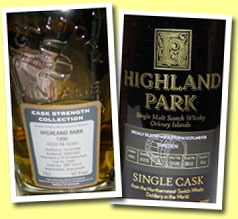 |
Highland Park 16 yo 1990/2007 (57.1%,
Signatory, cask #15687, 512 bottles)
 Colour: straw – gold.
Nose: typical of most Highland Parks
by Signatory (interesting to see consistency
here), starting on fresh butter, light
honey, apple juice and fresh milk
‘from the cow’. More oak
after that, lactones, white pepper
and ginger, getting back to honey
(should be heather, shouldn’t
it?) It gets also quite flinty. A
very ‘natural’ unsherried
Highland Park. With water: huge soapiness
at first (which, again, is normal),
getting then mashier, milkier and
yeastier. Rebirth? Hints of mint and
celery.
Colour: straw – gold.
Nose: typical of most Highland Parks
by Signatory (interesting to see consistency
here), starting on fresh butter, light
honey, apple juice and fresh milk
‘from the cow’. More oak
after that, lactones, white pepper
and ginger, getting back to honey
(should be heather, shouldn’t
it?) It gets also quite flinty. A
very ‘natural’ unsherried
Highland Park. With water: huge soapiness
at first (which, again, is normal),
getting then mashier, milkier and
yeastier. Rebirth? Hints of mint and
celery. |
| Mouth
(neat): creamier, oily, thick, almost
like fruit jelly. Apples, grapefruit,
apricot… But it gets a little
burning, it really needs water on
the palate (provided his swims well).
Let’s see… right, it gets
even fruitier, on orange drops, pineapple
drops, marshmallows… Full of
youth indeed. Finish: quite long,
still very fruity, with the oak starting
to appear (white pepper). A pretty
good youngish indie Highland Park.
84 points. |
Highland
Park 15 yo 1990/2005 (57.2%, OB, for
Sweden, cask #1602)
 Colour: full amber. Nose: punchy and
powerful, very candied, sherried,
with quite some smoke, roasted nuts
and praline. Notes of orange marmalade.
It’s a little too powerful though,
water is needed. With water: gets
even smokier, mineral, ‘wild’
(mushrooms, dead leaves) and more
chocolaty as well. Beautiful dryness,
with also whiffs of old library, soy
sauce, balsamic vinegar, cider apples…
Perfect sherried HP I think, already
quite complex at 15yo. Mouth (neat):
quite superb I must say. Maybe a tad
rough but the sherry is rather perfect,
toffeeish, smoked, toasted, honeyed
and candied, with a lively fruitiness
to balance the whole (tangerines,
oranges). Perfectly drinkable at cask
strength but let’s still try
it with a little water: that doesn’t
really bring it any extra-dimension
but it didn’t need any. Maybe
more notes of liqueur-filled chocolate.
Finish: very long, very compact, candied,
orangey and still quite smoky. Excellent,
perfect dryness. 90 points.
Colour: full amber. Nose: punchy and
powerful, very candied, sherried,
with quite some smoke, roasted nuts
and praline. Notes of orange marmalade.
It’s a little too powerful though,
water is needed. With water: gets
even smokier, mineral, ‘wild’
(mushrooms, dead leaves) and more
chocolaty as well. Beautiful dryness,
with also whiffs of old library, soy
sauce, balsamic vinegar, cider apples…
Perfect sherried HP I think, already
quite complex at 15yo. Mouth (neat):
quite superb I must say. Maybe a tad
rough but the sherry is rather perfect,
toffeeish, smoked, toasted, honeyed
and candied, with a lively fruitiness
to balance the whole (tangerines,
oranges). Perfectly drinkable at cask
strength but let’s still try
it with a little water: that doesn’t
really bring it any extra-dimension
but it didn’t need any. Maybe
more notes of liqueur-filled chocolate.
Finish: very long, very compact, candied,
orangey and still quite smoky. Excellent,
perfect dryness. 90 points.
|
| |
April
29, 2007 |
|
 |
CONCERT
REVIEW by Nick Morgan
VAN DER GRAAF GENERATOR The
Barbican, London, April 16th 2007 |
| I’m
sorry Serge, but I have to confess
that sometimes even I get it wrong.
I rushed at these tickets as soon
as the gig was announced. Van
der Graaf Generator!
Wow! And there in my mind was this
hazy memory of student parties and
yet another fairly pleasing ELP meets
King Crimson prog rock band, useful
gatefold sleeve albums and all. And
I had a striking image of Peter
Hammill, long curly locks, that
slightly effeminate boyish look, cheesecloth
shirt, and a voice from paradise.
And I’m sure he did nice folky
stuff after the band split, or between
their several manifestations in the
seventies – and didn’t
he have a sweet-lipped and sweet-singing
sister Claire
Hammill, sweeping Indian print
cotton skirts, coy in fields of daisies
and wildflowers, who teamed up with
Mike Oldfield on Tubular Bells and
all of that stuff? And for what it’s
worth the Photographer was sure she
met one time band member Charles Dickie
at some hippy hangout in Oxford. Yep
- it was all pretty clear to me and
my expectations apparent as we arrived
at the Barbican for this rare London
appearance. |
| From
1967 to 1978 the band went through
various line ups and had the usual
break-ups before calling it a day.
Front man Hammill pursued a prodigious
solo career. Then in 2005 the band
reformed with Hammill, saxophonist
David Jackson, keyboards man Guy Evans
and drummer Hugh Banton. A new album,
Present, was released and the band
toured with a major show at the Royal
Festival Hall, available in its entirety
on CD as Real Time. Following this,
Jackson departed from the fray once
more, taking with him the most distinctive
element of the Van der Graaf sound,
but the threesome returned to tour
in 2007. |
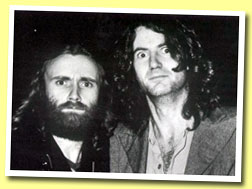
Peter Hammill (right) with Demis
Roussos
in 1977. Sorry, I mean with
Phill Collins |
| Did
I mention that, like the Fat Ladies,
they’ve just come back from
Limbourg (“a weird place”
as someone described it on Hammill’s
bulletin board) – that should
have told me something. So should
the audience – many of whom
(without wishing to be rude Serge)
would not have been out of place at
one of your whisky shows. And in fact
I had a serious double take when I
bumped into one who must have been
Serge’s twin brother –
so everyone can tell what they looked
like. Or at least the relatively normal
ones. There are a lot of single guys
here – arms tightly folded,
trousers too short, bodies slightly
rocking with the haunted eyes of deserted
East European orphans in some dreadful
children’s home. Some of them
are too close – remember, keep
an eye on them whatever happens. |
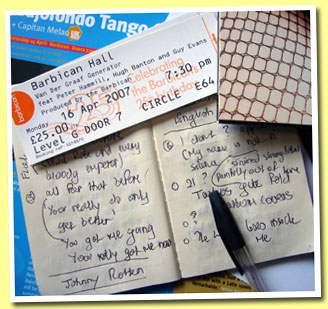 |
|
|
They
take the stage fifteen minutes late.
How can I describe what happened next?
Ok – let the black notebook
speak: ”singing flat”;
“Johnny Rotten”; “echo
pedal”; “Spinal Tap lyrics”;
“organist bass pedals”;
“delicate high-hat cymbal”;
“can they really have been this
bad”; “man across aisle
rocking violently and dribbling”;”
strained strangulated and often painfully
out of tune vocals”. You see,
Serge I just hadn’t done my
research and didn’t realise
they were really supposed to sound
like that. |
| No
wonder the Photographer – as
deluded as I was - was nearly lynched
when she surmised loudly halfway through
Hammill’s opening vocal efforts,
“Christ, he’s really lost
it hasn’t he?”. So I suppose
it was a love it or hate it moment
– and to be frank Hammill’s
vocal delivery is so extreme and (until
J. Rotten produced a fairly good pastiche
of it) unique, that it’s pretty
hard to love it at the first hearing.
In fact, perhaps I’d excised
it from my memory. And whilst I could
forgive the voice I still can’t
find it in my heart to be so charitable
about the lyrics, sometimes described
as Hammill’s “anguished
poetry”. |
| I
mean I know we all sang along to Pete
Sinfield’s ‘Court of the
Crimson King’ and stuff like
that back in the good old 1970s, but
that was because we had to make our
own entertainment then, and frankly
I’d be embarrassed to own up
to it now (oops!). So it’s one
of those moments when you either shake
your head solemnly at the profundity
of it all, or simple giggle uncomfortably.
Sorry VdGG fans – but I took
the giggle route. Take the opener,
‘Childlike faith in childhood’s
end’: “As anti-matter
sucks and pulses periodically the
bud unfolds, the bloom is dead, all
space is living history”. Well
possibly, but then think of this from
‘Every bloody emperor’,
“Unto nations nations speak
in the language of the gutter; trading
primetime insults the imperial impulse
extends across the screen”.
Pretty gloomy schoolboy radicalism
wouldn’t you say? And certainly
not for me. No – we’ll
draw a veil over the rest, apart from
the moment when Hammill sang “Am
I really here?” – at that
point my empathy was complete. |
| Of
course the fans (in other words everyone
else in the Barbican apart from the
Photographer and yours truly) loved
every minute of it, and possibly quite
rightly so. Guy Evans was astonishing
on keyboards and bass pedals (even
though he couldn’t help it sounding
like, well … ELP meets King
Crimson), and Banton’s ability
to move swiftly from sublime delicacy
to driving rhythms was outstanding.
And of course Mr Hammill is an accomplished
guitarist. Love it or hate it, take
it or leave it. So we left as ‘Man-erg’
came to a close (“The killer
lives inside me; yes, I can feel him
move”), which was just as well.
As I looked back and encore ‘Still
life’ began I could see the
rocking wraiths rising from their
seats like an army of Nosferatus.
We closed and barred the door behind
us, and made a run for it –
“somnolent muster - now the
dancing dead forsake the shelter of
their secure beds, awaken to a slumber
whose depths they dread…”
Blimey, that’s enough! |
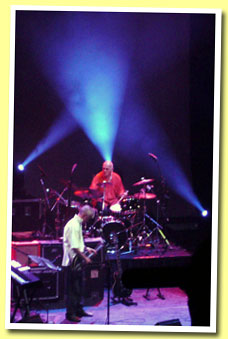 |
|
Oh, and by the way, if you’re
interested, Van der Graaf Generator
is a spelling mistake. - Nick
Morgan (concert photographs by Kate) |
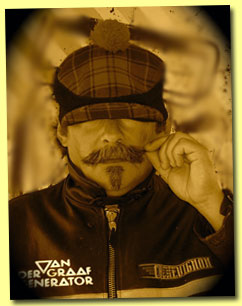 |
Thanks
Nick, but holy featherless crow,
so you met with my twin brother
Albert! We lost touch in the early
1980’s when, as a dedicated
anglophile - and Thatcherian -,
he decided to move to London’s
West End. I've heard he flew to
the Falklands at some point (I think
he had a malt distillery project
there with his buddy Ronnie van
Hilversum, “the southernmost
British distillery” or something
like that) but no news since then.
All we still had was this dusty
old yellowed photograph taken in
the late 1970’s. Blimey, I
should have guessed he would reappear
at a Van Der Graaf gig, he used
to be a fan and, by the way, his
favourite song was Killer.mp3.
Of course. - S. |
| TASTING
– TWO 1968 LONGMORNS BY THE
SMWS |
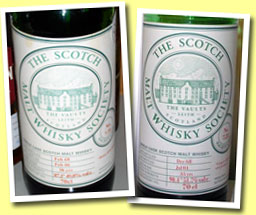 |
Longmorn
38 yo 1968/2006 (49.8%, Scotch Malt
Whisky Society, 7.35)
 Colour: mahogany. Nose: classical,
typical sherry nose but maybe lacking
a little oomph. Dry, a little cardboardy,
not extremely expressive. Okay, that
may sound a little severe, it’s
really excellent whisky but we’d
have liked a little more zing considering
this one’s ‘pedigree’.
Sure we have chocolate, coffee, gravy,
soy sauce, raisins, coal smoke…
But all that is a little shy.
Colour: mahogany. Nose: classical,
typical sherry nose but maybe lacking
a little oomph. Dry, a little cardboardy,
not extremely expressive. Okay, that
may sound a little severe, it’s
really excellent whisky but we’d
have liked a little more zing considering
this one’s ‘pedigree’.
Sure we have chocolate, coffee, gravy,
soy sauce, raisins, coal smoke…
But all that is a little shy. |
| Mouth:
much better despite a slightly bitter
rubberiness. We have old walnuts,
bitter chocolate, bitter caramel,
toasts… It gets (even) dryer
with time and a little tannic (over-infused
tea)… Right, if you like very
dry sherry, this is for you, although
the finish is a little sweeter (oranges
drops)… A very good old Longmorn
but I think it went a little over
the hill in fact, and got too dry.
But it’s still worth 85
points in my books. |
Longmorn
35 yo 1968/2004 (51.7%, Scotch Malt
Whisky Society, 7.25)
 Colour: mahogany. Nose: extremely
similar on the nose, maybe a tad less
chocolaty but much meatier and a little
more phenolic and resinous. Gets much
nicer than the 38 yo after a while,
with some beautiful organic notes
emerging. Forest, mushrooms, smoke…
Then litres of high-end balsamic vinegar,
also sherry vinegar, dried morels,
pure cocoa… Amazing how this
one developed on the nose, whilst
its bro stays much more restrained,
even after a good twenty minutes.
A matter of education, probably…
Mouth: oh yes, it’s certainly
better than the 38 yo on the palate.
Sweeter, rounder but not less complex
(yet compact), with lots of sultanas,
crystallized oranges, baklavas, chocolate,
apricots, toffee, café latte…
Not the most brilliant sherry monster
I’ve ever had but it’s
perfectly palatable in its own genre.
Nice medium-long finish, a little
fresher and fruitier (prunes). Very,
very good, like many old Longmorns
(but still no absolute winner). 90
points.
Colour: mahogany. Nose: extremely
similar on the nose, maybe a tad less
chocolaty but much meatier and a little
more phenolic and resinous. Gets much
nicer than the 38 yo after a while,
with some beautiful organic notes
emerging. Forest, mushrooms, smoke…
Then litres of high-end balsamic vinegar,
also sherry vinegar, dried morels,
pure cocoa… Amazing how this
one developed on the nose, whilst
its bro stays much more restrained,
even after a good twenty minutes.
A matter of education, probably…
Mouth: oh yes, it’s certainly
better than the 38 yo on the palate.
Sweeter, rounder but not less complex
(yet compact), with lots of sultanas,
crystallized oranges, baklavas, chocolate,
apricots, toffee, café latte…
Not the most brilliant sherry monster
I’ve ever had but it’s
perfectly palatable in its own genre.
Nice medium-long finish, a little
fresher and fruitier (prunes). Very,
very good, like many old Longmorns
(but still no absolute winner). 90
points. |
| |
April
28, 2007 |
|
 |
CONCERT
REVIEW by Nick Morgan
THE BAJOFONDO TANGO CLUB The
Barbican, London, April 14th 2007 |
| It’s
hotter than Buenos Aires in London.
There’s not a sardine to be
had from the fishmonger’s as
the west London air slowly fills with
the choking scent of garage-rusted
barbecues being torched into action
for the first time this year. On the
streets last season’s ill-fitting
summer clothes are out on display
along with an alarming surfeit of
flesh, much of it an almost Dickensian
tubercular off-white. The pre-gig
pizza is pleasingly piquant. Inside
the Barbican it’s hot and spicy
too - excited Spanish chatter fills
the foyer. It’s the second night
of La
Linea – the seventh London
Latin Music Festival – two weeks
of “new trends and moves in
the world of Latin music”. |
| Just
about to come on stage is Capitan
Melao led by Stereophonics
drummer Javier Weyler (an alliance
that perhaps celebrates the 25,000
Welsh speaking Argentinians who live
in the province of Chubut), who plays
guitar and sings, supported by guitar,
tapes and loops man Mariano Godov.
|
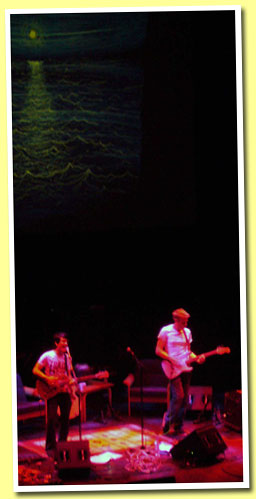
Capitan Melao |
|
|
Opening
song ‘Ser pos dos’ sets
the tone – spacey overlays
to a soft Latin beat and dreamy
lyrics – not quite living
up to the claim of “the seduction
of Bossa nova, the pain of a Bolero,
the anger of Rock”. It’s
all in the same vein – some
songs better than others –
but does liven up a bit when Phil
Manzanera (not just a Roxy Music
axeman but also a leading producer
and advocate of modern Latin American
music) joins for some typically
fuzzy lead guitar on ‘Terraplan’.
Pablo Giménez provides some
striking visuals in the background.
Oh and there’s a new album
(there always is), Lacrima, which
you can buy direct from their myspace
page.
It’s
a pleasing interlude, but despite
the enthusiasm of the audience it
does little to deter from the sense
of anticipation that fills the hall.
You see we’re actually here
to see the Bajofondo
Tango Club –
“the band that we were told
Gotan Project was”, led by
ageing Argentinian rocker and Oscar
winning composer Gustavo Santaolalla
(who plays the guitar and sings),
responsible for film scores such
as Babel, Motorcycle Diaries (from
which he plays a really sweet solo
guitar piece), Brokeback Mountain
and Amores Perros. |
| Sitting
next to us, in something of a fluster,
are Maurice and Dot Thistlethwaite,
leading lights of the Morecambe and
Heysham Tango and Crown Green Bowling
Association who’ve come all
the way from the Lune peninsula on
a coach (with their dancing shoes
round their necks) under the misapprehension
that it’s a dance night. But
from the initial notes of Javier Casalla’s
melancholy violin they, like the rest
of the audience, are totally won over
(actually its some sort of Stroh violin
- with a horn and resonator - with
a wonderful metallic scratchy sound).
“Infectious pounding tango rhythms,
almost hypnotic visuals from Vjay
Veronica Loza” says my little
black notebook after only ten minutes
or so. And so the evening went on,
and on, and on. Pretty good if you
liked infectious pounding tango rhythms,
but if not you were pretty stuck. |
| It’s
a fine balance to strike between tradition
and modernity – but although
they were the engine room of the band,
Juan Campodónico’s sequences
and loops never dominated either Casalla’s
playing, or the bandoneon of Martin
Ferres (who also played a wonderful
solo piece) – the instrument
that possibly most defines the Tango
sound. The battle between old and
new was captured in a fine piece which
saw Fernando
Santullo rap and exchange lines
with Santaolalla. And they tip their
hats to the great exponents of their
art both through the carefully chosen
film and photographic sequences and
samples from famous artists - whilst
not being scared to raise contemporary
issues in pieces such as Exodo II
(where the visuals deal explicitly
with the huge increase in emigration
from Argentina in recent years spurred
by the country’s faltering economy).
Believe me there’s a lot going
on – leaving the audience (even
Maurice and Dot) transfixed before
rising to their feet in rapturous
applause at the end of each song.
Did I mention there’s a lot
of national pride on display here
too? |
| “We
don't like the label 'electronic tango'
because we try to make a contemporary
music of Rio de la Plata, music from
Argentina, Uruguay” Santaolalla
told the Guardian, "…in
our case, it is kind of an active
melancholy. There's also power, rawness
- a savage element to tango we try
to keep alive. That connects to some
of the primal energy rock has."
He’s not joking. When these
boys really get going it gets close
to the Alabama 3 playing ‘Mao
Tse Tung’ (that scores about
fifteen out of ten in the primal rock
energy scale), and actually I regret
that we’re not stuck in the
sweaty Astoria enjoying this rather
than the rather stuffy Barbican. Or
so it seemed. Suddenly, without warning,
the stage was filled with dancers
from the audience as pianist Luciano
Supervielle discarded his keyboard
for turntables and scratched through
the last few songs. The doughty Barbican
stewards gave up the battle quickly.
Everyone was on their feet, and the
last I saw of Maurice he was swirling
Dot round in the middle of the crowded
stage, carnation clenched grimly between
her teeth. Like them you should buy
the eponymous album, and look out
for the new one which formed much
of the evening’s material, but
be warned – good though it is
the disc won’t really deliver,
this is a passionate visceral experience
to be savoured live, and in case you’re
wondering it’s far more memorable
than my piquant pizza. - Nick
Morgan (photographs by Kate) |
| Muchias
gracias, Nick. Nice to see that tango
is the thing in the UK these days,
maybe it’s a little more ‘infused’
in the common French culture, hence
less noticeable as a specific musical
entity, so to speak. But we do talk
about the Gotan Project as well…
Even if many purists (which I ain’t)
are pinching their noses a bit whilst
invoking Piazzolla, or even Gardel
and claiming that these new bands
are the Kenny G’s of tango.
Agreed, that’s pretty harsh.
By the way, was Manzanera really good?
I remember ‘801 Live’
as if it was yesterday, that was a
great record. I also seem to recall
he was amongst the four guitar masters
we had put on a pedestal at the time
(Santana, Zappa, Manzanera, Keef).
Okay, not Keef. But let’s have
a little Bajofondo Tango Club now,
with a piece called Perfume.mp3.
|
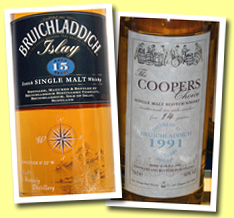 |
TASTING
– TWO BRUICHLADDICHS
Bruichladdich
15 yo (43%, OB, mid 1990’s)
 Didn’t we almost forget that
Bruichladdich was founded quite
a few years before the current owners
took over? Colour: gold. Nose: truly
Brucihladdich, with lots of melons
and fresh apricots right at first
sniffs. Nicely fruity indeed but
it gets then much grainier and even
slightly soapy, the fruitiness having
vanished. It’s also a little
mashy, yeasty, even papery (wet
newspaper) and very milky (lactones?)
Really average.
Didn’t we almost forget that
Bruichladdich was founded quite
a few years before the current owners
took over? Colour: gold. Nose: truly
Brucihladdich, with lots of melons
and fresh apricots right at first
sniffs. Nicely fruity indeed but
it gets then much grainier and even
slightly soapy, the fruitiness having
vanished. It’s also a little
mashy, yeasty, even papery (wet
newspaper) and very milky (lactones?)
Really average. |
| Mouth:
we have a little more caramel and
cereals here but the whole is quite
weak and papery again, kind of dusty
and sugary at the same time, although
we have nice notes of pine kernels.
I think it’s an excellent evidence
of the work done by the current owners
in selecting casks and doing their
vattings (just compare this old one
with the new 15yo, even the recent
finished version). Especially the
finish is a little too dry and cardboardy…
Below par even if certainly drinkable
(but there were some excellent older
10yo’s). 76 points. |
Bruichladdich
14 yo 1991/2006 (46%, Coopers Choice)
 Colour: white wine. Nose: a little
shier and more on fresh apples and
pears, with unusual hints of olive
oil, and then even black olives. Develops
quite slowly, getting a little grassy
and starting to smell almost like
tequila or maybe white rum, getting
then almost as mashy and slightly
soapy as the old 15yo. But it’s
got more freshness and is hence more
pleasant. A good example of the much
advertised ‘Atlantic freshness’
I guess. Mouth: more, much more body
now, with a distinctive ‘coastality’
(I think I never got it that loud
in a Bruichladich), hints of seashells,
iodine… And we have these hints
of olive oil as well, a little liquorice,
chervil, sage… A very entertaining,
with also a little quince and, maybe,
melons. Finish: rather long, quite
aromatic (hints of violets and lavender
swets), with also a little wax. Another
very pale and fresh one that should
stand ice in summer. I like this:
84 points.
Colour: white wine. Nose: a little
shier and more on fresh apples and
pears, with unusual hints of olive
oil, and then even black olives. Develops
quite slowly, getting a little grassy
and starting to smell almost like
tequila or maybe white rum, getting
then almost as mashy and slightly
soapy as the old 15yo. But it’s
got more freshness and is hence more
pleasant. A good example of the much
advertised ‘Atlantic freshness’
I guess. Mouth: more, much more body
now, with a distinctive ‘coastality’
(I think I never got it that loud
in a Bruichladich), hints of seashells,
iodine… And we have these hints
of olive oil as well, a little liquorice,
chervil, sage… A very entertaining,
with also a little quince and, maybe,
melons. Finish: rather long, quite
aromatic (hints of violets and lavender
swets), with also a little wax. Another
very pale and fresh one that should
stand ice in summer. I like this:
84 points. |
| |
April
27, 2007 |
|
 |
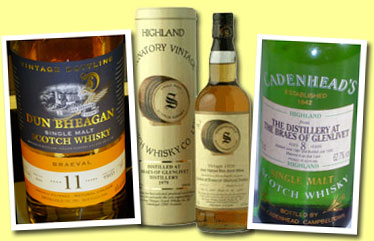 |
TASTING
– FOUR
BRAES OF GLENLIVET (no idea about
the plural, sorry – OK, BRAEVALS) |
Braeval 11 yo 1995/2006 (46%, Dun Bheagan,
cask #95653, 750 bottles)
 Colour: pale gold. Nose: archetypical
mashy, yeasty, porridgy and fruity
(apples and pears) young malt, developing
on a little ginger, cinchona and white
pepper. As natural (and maybe neutral)
as it can get. Gets more peppery with
time. Mouth: sweet, fruity (apple
compote and juice), grainy and quite
salty. Nothing too special but no
flaws. Finish: medium length, a little
sugary, mashy (potatoes, sweet corn)…
Good natural whisky but no thrills.
76 points.
Colour: pale gold. Nose: archetypical
mashy, yeasty, porridgy and fruity
(apples and pears) young malt, developing
on a little ginger, cinchona and white
pepper. As natural (and maybe neutral)
as it can get. Gets more peppery with
time. Mouth: sweet, fruity (apple
compote and juice), grainy and quite
salty. Nothing too special but no
flaws. Finish: medium length, a little
sugary, mashy (potatoes, sweet corn)…
Good natural whisky but no thrills.
76 points. |
Braes
of Glenlivet 16 yo 1979/1996 (59%,
Signatory, sherry butt #16045)
 All this series of 1979 Braes of Glenlivet
by Signatory were really excellent,
I hope this one won’t depart
from the rules. Colour: brownish.
Nose: big bold sherry of the meaty
and chocolaty kind. Reminds me of
that Mexican sauce (mole). Nice whiffs
of metal (aluminium pan), fir wood
smoke, rum, ham, gravy. Also remains
of yeasty and feinty notes. Gets more
vinous after a moment but rather beautifully
so (clean old wine cask, wine cellar,
moisture). We’re only missing
the spider’s webs… What’s
more, it’s easily nosable at
such high strength. Mouth: a very
impressive attack, coating, candied,
salty and very raisiny. Perfect sherry,
of the meaty and resinous kind again,
with also notes of dried apricots,
rancio and amaretto. Sure it’s
a little hot but water seems to be
superfluous. I beg your pardon? Okay,
okay, let’s try (while the nose
got even more ‘organic’):
the salt is even more apparent but
the general profile stays the same.
No sulphur or rubber revealed whatsoever.
Finish: long, still beautifully sherried
and elegant, complex, meaty…
Finishes on Corinth raisins. In short,
another excellent cask from that series,
worth searching for (just like, for
instance the famous 1980 Fettercairns
by the same bottler). 90 points.
All this series of 1979 Braes of Glenlivet
by Signatory were really excellent,
I hope this one won’t depart
from the rules. Colour: brownish.
Nose: big bold sherry of the meaty
and chocolaty kind. Reminds me of
that Mexican sauce (mole). Nice whiffs
of metal (aluminium pan), fir wood
smoke, rum, ham, gravy. Also remains
of yeasty and feinty notes. Gets more
vinous after a moment but rather beautifully
so (clean old wine cask, wine cellar,
moisture). We’re only missing
the spider’s webs… What’s
more, it’s easily nosable at
such high strength. Mouth: a very
impressive attack, coating, candied,
salty and very raisiny. Perfect sherry,
of the meaty and resinous kind again,
with also notes of dried apricots,
rancio and amaretto. Sure it’s
a little hot but water seems to be
superfluous. I beg your pardon? Okay,
okay, let’s try (while the nose
got even more ‘organic’):
the salt is even more apparent but
the general profile stays the same.
No sulphur or rubber revealed whatsoever.
Finish: long, still beautifully sherried
and elegant, complex, meaty…
Finishes on Corinth raisins. In short,
another excellent cask from that series,
worth searching for (just like, for
instance the famous 1980 Fettercairns
by the same bottler). 90 points. |
Braes
of Glenlivet 8 yo 1987/1995 (62.7%,
Cadenhead)  Colour: pale gold. Nose: much more
harsh, pungent, spirity… Close
to raw alcohol. Quick, water: loads
of vanilla and caramel but that’s
pretty all. Now, I quite like vanilla
and caramel. Mouth (neat): I’m
sorry but ‘ouch!’ With
water: very sugary. Nutshell: sugared
alcohol. Not undrinkable, that is,
but this is not why we’re into
whisky. 65 points.
Colour: pale gold. Nose: much more
harsh, pungent, spirity… Close
to raw alcohol. Quick, water: loads
of vanilla and caramel but that’s
pretty all. Now, I quite like vanilla
and caramel. Mouth (neat): I’m
sorry but ‘ouch!’ With
water: very sugary. Nutshell: sugared
alcohol. Not undrinkable, that is,
but this is not why we’re into
whisky. 65 points. |
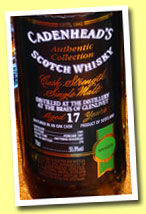 |
Braes
of Glenlivet 17 yo 1989/2007 (55.9%,
Cadenhead, 276 bottles)  This one comes from a Sauternes hogshead.
Rather curious… Colour: full
gold. Nose: very spirity, buttery
and caramelised at first nosing, with
whiffs of oak sawdust that grow bigger
and bigger. Also hints of ginger and
cinnamon but the whole is quite simple
and raw. Something green in the background
(newly cut grass). Not unpleasant
but rough. Mouth: very sweet and kirschy,
with notes of distillation. Quite
some vanilla and milk chocolate but
the rest is rather simple and almost
neutral, except for hints of ripe
apricots and plums, all that being
slightly ‘vulgar here’.
A hot, raw spirit. Finish: rather
long, hot, like fruit spirit mixed
with caramel and vanilla. A hipflask
malt to warm you up in winter, quite
oaky. 77 points.
This one comes from a Sauternes hogshead.
Rather curious… Colour: full
gold. Nose: very spirity, buttery
and caramelised at first nosing, with
whiffs of oak sawdust that grow bigger
and bigger. Also hints of ginger and
cinnamon but the whole is quite simple
and raw. Something green in the background
(newly cut grass). Not unpleasant
but rough. Mouth: very sweet and kirschy,
with notes of distillation. Quite
some vanilla and milk chocolate but
the rest is rather simple and almost
neutral, except for hints of ripe
apricots and plums, all that being
slightly ‘vulgar here’.
A hot, raw spirit. Finish: rather
long, hot, like fruit spirit mixed
with caramel and vanilla. A hipflask
malt to warm you up in winter, quite
oaky. 77 points. |
| MUSIC
– Recommended
listening: the ueber-fantastic Jeanne
Lee sings Rain.mp3
in 1993 with David Eyges on cello.
Let's all remember the great Jeanne
Lee and buy her music. |
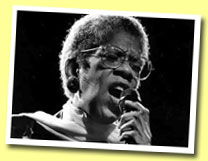 |
| |
April
26, 2007 |
|
 |
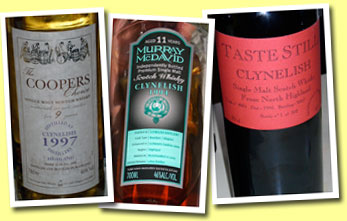 |
TASTING
– THREE YOUNG CLYNELISHES |
Clynelish
9 yo 1997/2006 (46%, Coopers Choice)
 Colour: pale white wine. Nose: this
is extremely playful, very fruity
(gooseberries, green apples, bananas)
and slightly mineral and waxy as usual.
Still quite simple but already nicely
balanced, with a little pepper already
starting to come through. Also quite
some fresh butter and a faint yeastiness.
Nose: a little less of plain fruit
juice this time, starting much grassier
and even a little bitter. It’s
also unusually tarry, getting then
mashy and slightly milky. Very natural
– maybe a little neutral, actually.
Good spirit but it would probably
benefit from further ageing. Finish:
rather long, fruitier again but very
simple despite the notes of liquorice
all-sorts. Not quite ‘Clynelish’
yet. 78 points.
Colour: pale white wine. Nose: this
is extremely playful, very fruity
(gooseberries, green apples, bananas)
and slightly mineral and waxy as usual.
Still quite simple but already nicely
balanced, with a little pepper already
starting to come through. Also quite
some fresh butter and a faint yeastiness.
Nose: a little less of plain fruit
juice this time, starting much grassier
and even a little bitter. It’s
also unusually tarry, getting then
mashy and slightly milky. Very natural
– maybe a little neutral, actually.
Good spirit but it would probably
benefit from further ageing. Finish:
rather long, fruitier again but very
simple despite the notes of liquorice
all-sorts. Not quite ‘Clynelish’
yet. 78 points. |
Clynelish
11 yo 1994/2005 (46%, Murray McDavis,
bourbon/viognier, 1800 bottles)  Murray McDavid go on with their wine
encyclopaedia, this time it’s
viognier, a white grape variety used
mainly in the Rhone valley (here in
Condrieu). Viognier is said not to
age too well but when it’s young,
it gives extremely classy whites,
quite spicy and usually quite ‘round’
yet demonstrative. But viognier needs
good terroir, otherwise it gets a
little lumpish. Not in Condrieu, that
is! Anyway, let’s try this whisky…
Colour: amber. Nose: oh, this is very
interesting, the casks seem to have
given it kind of an old bottle effect.
Really, it smells almost like a sherried
whisky that spent at least twenty
years in glass (if you’re a
winemaker from Condrieu, watch your
casks!) We have something slightly
metallic, musty, nutty, farmy and
animal (clean horse), with also hints
of musk and Seville oranges. How interesting
and ‘funny’! Too bad Condrieu
is so small… Mouth: the effect
is not quite as striking as on the
nose but we’re well in the same
‘trend’. Quite concentrated,
‘old-sherried’, toasted,
coffeeish, orangey, liquoricy, with
this mustiness again (hints of wild
mushrooms, pu-erh tea). Lots of spices
as well (mostly cloves) and maybe
just a slight dryness from the rather
heavy oak that takes the lead after
a moment. A great whisky to play dirty
tricks to your friend (you know, ‘tell
me what this is!’) Finish: rather
long, candied and gingerier now, with
Clynelish’s trademark waxiness
as a signature. Surprisingly great,
I’d say. 89 points.
Murray McDavid go on with their wine
encyclopaedia, this time it’s
viognier, a white grape variety used
mainly in the Rhone valley (here in
Condrieu). Viognier is said not to
age too well but when it’s young,
it gives extremely classy whites,
quite spicy and usually quite ‘round’
yet demonstrative. But viognier needs
good terroir, otherwise it gets a
little lumpish. Not in Condrieu, that
is! Anyway, let’s try this whisky…
Colour: amber. Nose: oh, this is very
interesting, the casks seem to have
given it kind of an old bottle effect.
Really, it smells almost like a sherried
whisky that spent at least twenty
years in glass (if you’re a
winemaker from Condrieu, watch your
casks!) We have something slightly
metallic, musty, nutty, farmy and
animal (clean horse), with also hints
of musk and Seville oranges. How interesting
and ‘funny’! Too bad Condrieu
is so small… Mouth: the effect
is not quite as striking as on the
nose but we’re well in the same
‘trend’. Quite concentrated,
‘old-sherried’, toasted,
coffeeish, orangey, liquoricy, with
this mustiness again (hints of wild
mushrooms, pu-erh tea). Lots of spices
as well (mostly cloves) and maybe
just a slight dryness from the rather
heavy oak that takes the lead after
a moment. A great whisky to play dirty
tricks to your friend (you know, ‘tell
me what this is!’) Finish: rather
long, candied and gingerier now, with
Clynelish’s trademark waxiness
as a signature. Surprisingly great,
I’d say. 89 points. |
Clynelish
1995/2007 (50%, Taste Still, Whisky
Live Verviers 2007, 302 bottles)  Colour: white wine.
Nose: we’re closer to the 1997,
obviously, but this one is much less
fruity and quite sharper at first
nosing – and it’s not
only the alcohol, although it’s
quite spirity. Quite grassy, mineral,
with notes of paraffin and linseed
oil. Maybe a little austere I’d
say, but very clean. An interesting
meatiness in the background (oxtail).
And it gets hugely waxy after ten
of fifteen minutes and quite farmier
at the same time. Superb in fact,
but it really needs a lot of time.
Oh, and it gets also much smokier!
(coal and wood). Mouth: powerful and
much, much fruitier. We have strawberries
and apples, litres of orange juice
and ginger tonic (a good one) as well
as something like peat, that I didn’t
quite get on the nose. Wait a second,
peat? Yes, really, peat – and
did I already mention wax? Yes, rings
a bell. We’ve had Broras from
the 1980’s that had roughly
the same profile. It gets more peppery
after that, with also notes of curry
and ‘that mix of spices that
they use in North Africa to improve
just any dishes’. Yeah, I know,
that’s pretty useless comments
if you haven’t been there but
believe me, this Clynelish really
tastes like that spice mix (‘for
lazy cooks’ as they say over
there). Anyway, it’s superb
whisky – provided you give it
a lot of time, which we don’t
always do with youngsters like this
one. A shame. Finish: long, with all
the dimensions mingling now, fruits,
phenols and spices. Just excellent
but again, you have to give it time
– yeah. It’s with its
young whiskies that you can check
a distillery’s class. 90
points.
Colour: white wine.
Nose: we’re closer to the 1997,
obviously, but this one is much less
fruity and quite sharper at first
nosing – and it’s not
only the alcohol, although it’s
quite spirity. Quite grassy, mineral,
with notes of paraffin and linseed
oil. Maybe a little austere I’d
say, but very clean. An interesting
meatiness in the background (oxtail).
And it gets hugely waxy after ten
of fifteen minutes and quite farmier
at the same time. Superb in fact,
but it really needs a lot of time.
Oh, and it gets also much smokier!
(coal and wood). Mouth: powerful and
much, much fruitier. We have strawberries
and apples, litres of orange juice
and ginger tonic (a good one) as well
as something like peat, that I didn’t
quite get on the nose. Wait a second,
peat? Yes, really, peat – and
did I already mention wax? Yes, rings
a bell. We’ve had Broras from
the 1980’s that had roughly
the same profile. It gets more peppery
after that, with also notes of curry
and ‘that mix of spices that
they use in North Africa to improve
just any dishes’. Yeah, I know,
that’s pretty useless comments
if you haven’t been there but
believe me, this Clynelish really
tastes like that spice mix (‘for
lazy cooks’ as they say over
there). Anyway, it’s superb
whisky – provided you give it
a lot of time, which we don’t
always do with youngsters like this
one. A shame. Finish: long, with all
the dimensions mingling now, fruits,
phenols and spices. Just excellent
but again, you have to give it time
– yeah. It’s with its
young whiskies that you can check
a distillery’s class. 90
points. |
| MUSIC
– Recommended
listening: she sadly passed away in
May 1990 at the age of 32 but Emily
Remler managed to amaze
crowds of jazz fans before she went
to the stars. Let's listen to her
playing the standard Softly
as in a morning sunrise.mp3 -
wasn't she good? Please buy her recordings... |
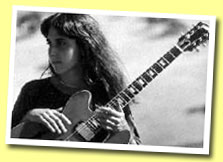 |
| |
April
25, 2007 |
|
 |
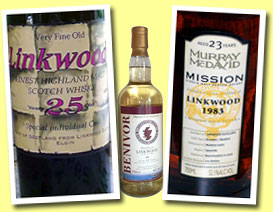 |
TASTING
– THREE LINKWOODS |
Linkwood
25 yo (40%, G&M for Sestante, mid-1980's)
 With its famous yellow brick label
– don’t know if Elton’s
a fan. Colour: gold. Nose: this is
very nice. Very elegant, very honeyed
and delicately toffeeish, with whiffs
of wood smoke, liquorice and a little
‘good’ rubber, developing
on apricot pie and plum jam, orange
cake, roasted nuts and toasted brioche.
Hints of wine-poached pears. Hints
of metal polish (OBE). Very classical,
maybe not extremely complex but the
balance is perfect. Mouth: oh, too
bad, it’s weaker and much drier
than expected at the attack, also
quite caramelly and a little cardboardy.
It improves with time, getting also
bolder but always a little too caramelly.
Toasted cake, roasted nuts, nougat…
And a better finish, medium long,
slightly minty and quite liquoricy,
with hints of Turkish delights. A
little mastic and a little salt as
well. Good old Linkwood, extremely
drinkable but there’s more happening
on the nose than on the palate. Yes,
again. 86 points.
With its famous yellow brick label
– don’t know if Elton’s
a fan. Colour: gold. Nose: this is
very nice. Very elegant, very honeyed
and delicately toffeeish, with whiffs
of wood smoke, liquorice and a little
‘good’ rubber, developing
on apricot pie and plum jam, orange
cake, roasted nuts and toasted brioche.
Hints of wine-poached pears. Hints
of metal polish (OBE). Very classical,
maybe not extremely complex but the
balance is perfect. Mouth: oh, too
bad, it’s weaker and much drier
than expected at the attack, also
quite caramelly and a little cardboardy.
It improves with time, getting also
bolder but always a little too caramelly.
Toasted cake, roasted nuts, nougat…
And a better finish, medium long,
slightly minty and quite liquoricy,
with hints of Turkish delights. A
little mastic and a little salt as
well. Good old Linkwood, extremely
drinkable but there’s more happening
on the nose than on the palate. Yes,
again. 86 points. |
Linkwood
18 yo 1983 (46%, Wallace Milroy for
Benivor)  Colour: white wine. Nose: this one
starts much more on vanilla crème
and gets then even smokier than the
old 25yo, with also hints of aniseed,
celery and cooked salsify. Or is it
swede? Gets grassier with time, maybe
a little indefinite actually. Quite
some caramel and toasted cake –
also wet newspaper, which isn’t
really good news. Mouth: a rather
bold and powerful attack, mostly on
liquorice and caramel but it sort
of falls apart then and the middle
is weaker – and a little grainy.
Finish: longer now but still a little
too caramelly for my tastes, with
also something like mint-flavoured
liquorice drops. Not bad at all but
no winner, I’d say. 78
points.
Colour: white wine. Nose: this one
starts much more on vanilla crème
and gets then even smokier than the
old 25yo, with also hints of aniseed,
celery and cooked salsify. Or is it
swede? Gets grassier with time, maybe
a little indefinite actually. Quite
some caramel and toasted cake –
also wet newspaper, which isn’t
really good news. Mouth: a rather
bold and powerful attack, mostly on
liquorice and caramel but it sort
of falls apart then and the middle
is weaker – and a little grainy.
Finish: longer now but still a little
too caramelly for my tastes, with
also something like mint-flavoured
liquorice drops. Not bad at all but
no winner, I’d say. 78
points. |
Linkwood
23 yo 1983/2006 (52.1%, Murray McDavid
Mission Gold, enhanced in Madeira
casks, 700 bottles)
 Colour: gold. Nose: Madeira is the
finishing I like best (except for
a few odd Sauternes and other sweet
whites, eh!) and it seems it’s
not this one that’ll make me
change my mind. It’s pretty
much like the other 1983 actually,
but everything is sort of magnified
besides the farmy smokiness and dryness
from the Madeira (I think). Develops
on rather beautiful notes of wet undergrowth,
mushrooms, moss, fern… Quite
some liquorice as well, coal, shoe
polish, old leather, pipe tobacco…
If the spirit was anything like the
‘Benivor’ before it got
‘enhanced’, well, it’s
an enhancement indeed. Mouth: exactly
the same happens, lots of liquorice,
caramel and mint but also a much heavier
vinosity than on the nose, with also
quite some tannins, grape seeds and
skin, getting rougher with time, especially
at the finish that’s still quite
rough and vinous. But the nose was
super-great! More a perfume than a
malt to drink, maybe… 80
points (for the beautiful
nose).
Colour: gold. Nose: Madeira is the
finishing I like best (except for
a few odd Sauternes and other sweet
whites, eh!) and it seems it’s
not this one that’ll make me
change my mind. It’s pretty
much like the other 1983 actually,
but everything is sort of magnified
besides the farmy smokiness and dryness
from the Madeira (I think). Develops
on rather beautiful notes of wet undergrowth,
mushrooms, moss, fern… Quite
some liquorice as well, coal, shoe
polish, old leather, pipe tobacco…
If the spirit was anything like the
‘Benivor’ before it got
‘enhanced’, well, it’s
an enhancement indeed. Mouth: exactly
the same happens, lots of liquorice,
caramel and mint but also a much heavier
vinosity than on the nose, with also
quite some tannins, grape seeds and
skin, getting rougher with time, especially
at the finish that’s still quite
rough and vinous. But the nose was
super-great! More a perfume than a
malt to drink, maybe… 80
points (for the beautiful
nose). |
MUSIC
– Recommended
listening: today it's David
Garland and In
my room.mp3 (a song by Brian
Wilson) sung in 1993, that was on
'I guess I Just Wasn’t Made
for These Times'. Please buy David
Garland's great music. |
 |
| |
April
24, 2007 |
|
 |
| PETE
McPEAT AND JACK WASHBACK |
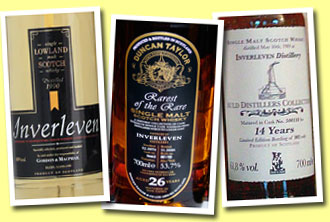 |
TASTING
– THREE INVERLEVENS
|
Inverleven
1990/2005 (40%, Gordon & MacPhail
licensed bottling)
 Colour: white wine. Nose: rather expressive
but simple it seems, starting mostly
on pears and apple juice. Less mashy
or yeasty notes than in a double-distilled
youngish malt. Gets even more delicately
fruity after a moment (cherries, pineapples)
but also a little too bubblegummy.
Slight hints of Muscat, rose jelly,
maybe lychees… Certainly cleaner
than earlier versions of this G&M
‘black label’. Mouth:
fruity again but also quite spicy
(pepper) despite the slightly weakish
attack. It’s also yeastier now
(beer), porridgy, vanilled…
But also a little disjointed. Not
much pleasure here. Finish: quite
short and curiously tannic now, with
notes of various herbal tea and touches
of nutmeg. Okay, the nose was pleasantly
fruity and fresh but the palate is
a little too indefinite for my tastes.
74 points.
Colour: white wine. Nose: rather expressive
but simple it seems, starting mostly
on pears and apple juice. Less mashy
or yeasty notes than in a double-distilled
youngish malt. Gets even more delicately
fruity after a moment (cherries, pineapples)
but also a little too bubblegummy.
Slight hints of Muscat, rose jelly,
maybe lychees… Certainly cleaner
than earlier versions of this G&M
‘black label’. Mouth:
fruity again but also quite spicy
(pepper) despite the slightly weakish
attack. It’s also yeastier now
(beer), porridgy, vanilled…
But also a little disjointed. Not
much pleasure here. Finish: quite
short and curiously tannic now, with
notes of various herbal tea and touches
of nutmeg. Okay, the nose was pleasantly
fruity and fresh but the palate is
a little too indefinite for my tastes.
74 points. |
Inverleven
26 yo 1979/2006 (53.7%, Duncan Taylor
Rarest of the Rare, cask #5662, 193
bottles)  Colour: pale gold. Nose: spirity and
woody (to say the least), smelling
almost like oak-matured cologne. Freshly
sawn plank, sawdust, vanilla…
A lot of lactones. Develops on light
caramel, milk chocolate and praline…
Midway between a well-oaked young
Glenmorangie (Artisan Cask etc.) and
an old grain whisky. Slight floweriness
coming through after a while (yellow
flowers such as buttercups and dandelions).
Simple but very clean. Mouth: lots
of body and more complexity it seems,
even if the huge oakiness may well
do most of the job. Pepper, vanilla,
nutmeg, caramel, nuts, dried pears,
lots of ginger, speculoos… And
then even more pepper. Very compact.
Finish: long, clean despite the heavy
oakiness, spicy… Not unlike
well-matured grain whisky indeed.
83 points.
Colour: pale gold. Nose: spirity and
woody (to say the least), smelling
almost like oak-matured cologne. Freshly
sawn plank, sawdust, vanilla…
A lot of lactones. Develops on light
caramel, milk chocolate and praline…
Midway between a well-oaked young
Glenmorangie (Artisan Cask etc.) and
an old grain whisky. Slight floweriness
coming through after a while (yellow
flowers such as buttercups and dandelions).
Simple but very clean. Mouth: lots
of body and more complexity it seems,
even if the huge oakiness may well
do most of the job. Pepper, vanilla,
nutmeg, caramel, nuts, dried pears,
lots of ginger, speculoos… And
then even more pepper. Very compact.
Finish: long, clean despite the heavy
oakiness, spicy… Not unlike
well-matured grain whisky indeed.
83 points. |
Inverleven
14 yo 1989 (61.8%, JWWW Auld Distillers,
cask #500118, 2005)
 Colour:
full gold. Nose: more body and more
oomph, and more sherry. It seems that
this is from a refill butt or something.
Notes of fresh walnuts, vanilla, cocoa…
Lots of oak but then we get more or
less the same fruity bubblegummy notes
as in the G&M. Notes of beer (ale)
and apple skins. With water: oh, what
an amazing development! It got completely
different, meaty and farmy (sort of
perverse), on well-hung game, rotting
fruits (not yet rotten), old wine
cellar… Then mega-huge notes
of balsamico and sake… Extremely
interesting, provided you don’t
forget to water it down a bit. Quite
superb. Mouth (neat): extremely nutty,
coffeeish, liquoricy and caramelly
but really too strong. Quick, water
is needed: right, it does get much
better again, more toffee-ish and
coffee-ish this time but also very
salty. Even more liquorice. Straighter
and cleaner than on the nose when
diluted but that’s not really
good news here. Finish: long, salty
and vanillas, grassier, with the (probable)
sherry wood doing a remarkable comeback.
An excellent surprise, this Inverleven,
especially on the nose. A malt that’s
got something of Dr. Jeckyll and Mr.
Hyde. 88 points. Colour:
full gold. Nose: more body and more
oomph, and more sherry. It seems that
this is from a refill butt or something.
Notes of fresh walnuts, vanilla, cocoa…
Lots of oak but then we get more or
less the same fruity bubblegummy notes
as in the G&M. Notes of beer (ale)
and apple skins. With water: oh, what
an amazing development! It got completely
different, meaty and farmy (sort of
perverse), on well-hung game, rotting
fruits (not yet rotten), old wine
cellar… Then mega-huge notes
of balsamico and sake… Extremely
interesting, provided you don’t
forget to water it down a bit. Quite
superb. Mouth (neat): extremely nutty,
coffeeish, liquoricy and caramelly
but really too strong. Quick, water
is needed: right, it does get much
better again, more toffee-ish and
coffee-ish this time but also very
salty. Even more liquorice. Straighter
and cleaner than on the nose when
diluted but that’s not really
good news here. Finish: long, salty
and vanillas, grassier, with the (probable)
sherry wood doing a remarkable comeback.
An excellent surprise, this Inverleven,
especially on the nose. A malt that’s
got something of Dr. Jeckyll and Mr.
Hyde. 88 points. |
And
also Dumbarton
(Inverleven Stills) 18 yo 1987/2006
(57.9%, Cadenhead's, 276 bottles)
 Colour: straw. Nose: this one is very,
very lemony, sharp and austere –
rather beautifully so. Alas, it gets
then slightly ‘chemical’,
with whiffs of seltzer and lots of
newly cut grass. Notes of plastic
(new car – not an Aston, that
is) and ham. Mouth: better again at
the attack, extremely fruity, playful
(grapefruits), with also notes of
ginger ale and milk. But it gets then
a little dirty again, cardboardy,
with again something quite chemical.
The whole gets rougher and rougher
with time, very grassy and even a
little soapy. The finish is quite
long but still a little rough and
soapy. A malt that’s got good
and bad sides but it’s not even
near the 1989. 69 points.
Colour: straw. Nose: this one is very,
very lemony, sharp and austere –
rather beautifully so. Alas, it gets
then slightly ‘chemical’,
with whiffs of seltzer and lots of
newly cut grass. Notes of plastic
(new car – not an Aston, that
is) and ham. Mouth: better again at
the attack, extremely fruity, playful
(grapefruits), with also notes of
ginger ale and milk. But it gets then
a little dirty again, cardboardy,
with again something quite chemical.
The whole gets rougher and rougher
with time, very grassy and even a
little soapy. The finish is quite
long but still a little rough and
soapy. A malt that’s got good
and bad sides but it’s not even
near the 1989. 69 points. |
| |
April
23, 2007 |
|
 |
| TASTING
– TWO OLD CLYNELISHES |
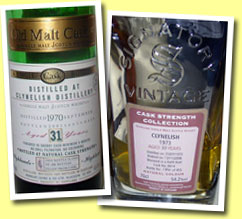 |
Clynelish
31 yo 1970/2001 (48.4%, Douglas Laing
Old Malt Cask, 186 bottles)
 Colour: full gold. Nose: this one
really makes the air fragrant with
the scent of fresh apple juice whilst
first sniffs from the glass reveal
more freshly sawn oak, vanilla, ripe
peaches and a little wax. Goes on
with notes of pollen, flower nectar
and apple skin but the whole is much
less extravagantly fruity than most
1971’s or 1972’s –
and not peaty at all. I wouldn’t
have recognised an old Clynelish,
had I tried this one blind.
Colour: full gold. Nose: this one
really makes the air fragrant with
the scent of fresh apple juice whilst
first sniffs from the glass reveal
more freshly sawn oak, vanilla, ripe
peaches and a little wax. Goes on
with notes of pollen, flower nectar
and apple skin but the whole is much
less extravagantly fruity than most
1971’s or 1972’s –
and not peaty at all. I wouldn’t
have recognised an old Clynelish,
had I tried this one blind. |
| Mouth:
a very sweet and oaky attack, a little
indefinite. We have apple juice again,
black pepper and lots of ginger but
it’s soon to get drying and
as tea-ish as, well, over-infused
tea. Finish: long but very oaky and
peppery, with just a pinch of salt.
Good whisky but it’s globally
a disappointment I think. Maybe they
were still fine-tuning the brand new
distillery at the time. 82
points. |
Clynelish
33 yo 1973/2006 (54.2%, Signatory,
cask #8914, 455 bottles)  A sister cask of the two excellent
Prestonfields that were selected by
la Maison du Whisky last year. Colour:
white wine – pale straw. Nose:
ah, good news, this is much more typically
Clynelish. More phenolic and much
more lemony, with a beautiful sharpness
and quite some peat, although less
than in the first Prestonfield. Hints
of pineapples, humus, grated lemon
skin, grapefruits, green tea (or rather
white tips), beech wood smoke…
Also ripe gooseberries… Quite
some oak as well but it’s perfectly
integrated. What a lovely and complex
nose! Mouth: this is considerably
better than the 1970. The attack is
totally Clynelish, waxy, superbly
citrusy and beautifully spicy (various
peppers). We have also quite some
lemon balm, spearmint, peat, oak…
Then crystallised orange and lemon
zests. It’s actually a little
rougher than the Prestonfields, maybe
it could have stayed in its cask for
at least five or ten more years. Finish:
very long, lemony, peaty and peppery,
with always quite some wax and the
usual dash of salt. Very slight cardboardiness,
which is the only (very, very small)
flaw. 91 points.
A sister cask of the two excellent
Prestonfields that were selected by
la Maison du Whisky last year. Colour:
white wine – pale straw. Nose:
ah, good news, this is much more typically
Clynelish. More phenolic and much
more lemony, with a beautiful sharpness
and quite some peat, although less
than in the first Prestonfield. Hints
of pineapples, humus, grated lemon
skin, grapefruits, green tea (or rather
white tips), beech wood smoke…
Also ripe gooseberries… Quite
some oak as well but it’s perfectly
integrated. What a lovely and complex
nose! Mouth: this is considerably
better than the 1970. The attack is
totally Clynelish, waxy, superbly
citrusy and beautifully spicy (various
peppers). We have also quite some
lemon balm, spearmint, peat, oak…
Then crystallised orange and lemon
zests. It’s actually a little
rougher than the Prestonfields, maybe
it could have stayed in its cask for
at least five or ten more years. Finish:
very long, lemony, peaty and peppery,
with always quite some wax and the
usual dash of salt. Very slight cardboardiness,
which is the only (very, very small)
flaw. 91 points. |
| MUSIC
–
Recommended
listening: rather solar and experimental
Scottish band The
Beta band play Dr.
Baker.mp3. Too bad they didn't
pull enough success and disappeared
after a few years... But you may still
be able to buy their music. |
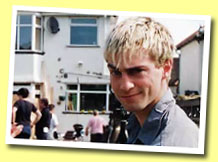 |
| |
April
22, 2007 |
|
 |
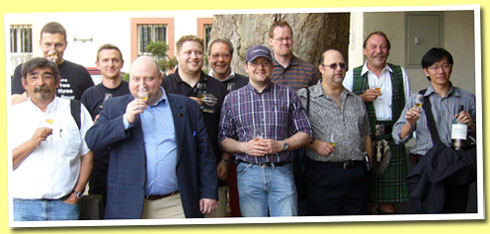 |
| HI!
- A bunch of Malt Maniacs from three
continents salute you from the Whisky
Fair Limburg (Germany). From left
to right: Serge, Olivier, Thomas,
Konstantin, Pit, Michel, Bert, Robert,
Peter, Charlie and Ho-cheng. |
| |
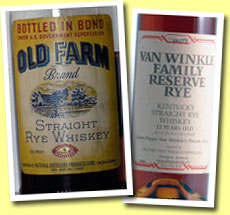 |
TASTING
– TWO RYE WHISKEYS
Old
Farm 5 yo (100° US proof, OB,
National Distillers,1938)
 I’m trembling at the very
thought of any American whiskey
freak reading these lines, as I
know next to nothing about US spirits
and as this is a first for me, if
my memory serves me right –
and please don’t expect nuances.
So, please guys, I’m asking
you to show leniency today, especially
since this is pre-war rye whisky
from Kentucky.
I’m trembling at the very
thought of any American whiskey
freak reading these lines, as I
know next to nothing about US spirits
and as this is a first for me, if
my memory serves me right –
and please don’t expect nuances.
So, please guys, I’m asking
you to show leniency today, especially
since this is pre-war rye whisky
from Kentucky. |
| Colour:
full amber. Nose: the first smells
I get are alcohol and caramel, yet
it’s far from being unpleasant,
quite the opposite. The whiskey gets
then a little more complex, with a
very pleasant oakiness, notes of roasted
nuts, dry grated coconut and vanilla,
rum, grain whisky like they make in,
err, Scotland… And it keeps
developing, with a little mint now
and quite some notes of shoe polish.
Not tired at all, to say the least,
and not that far from a great Scotch.
Mouth: lots happening at the attack!
Lots of oomph, starting on spirit,
caramel, honey and oak, the whole
mingling into something smoother but
still very firm, not too far from
good dark rum. And this spent 70 years
in a bottle! Amazing… There’s
also a little salt (isn’t that
bizarre?) and a little treacle as
well as a little salted liquorice.
Excellent. Finish: very long, almost
endless, liquoricy, caramelly and
still a little salty. A truly indestructible
whiskey and a great discovery. Check
the antiques shops! Rating: I don’t
feel comfortable with rating American
whiskey as I seriously lack experience,
but let’s say between 85 and
90, closer to 90 points
actually. (and thanks, Marcel) |
| Van
Winkle Family Reserve Rye 13 yo 1985
(50.0%, OB, rye, No. A2539)
Colour: full amber, exactly the same
as the Old Farm’s. Nose: ah,
this is completely different indeed.
Even more spirity at first nosing,
with whiffs of bubblegum and strawberry-flavoured
barley sugar and then immense notes
of varnish and nail polish remover.
Thanks God, all that settles down
after a while and we get closer to…
err, civilisation, with quite some
roasted nuts again, vanilla crème,
burnt oak, caramel and pure oak (fresh
sawdust). But it’s far less
complex and rounded than the oldie
on the nose, maybe the palate will
be greater. Mouth: hmmm, if this is
rye, then I don’t like rye.
I think the global taste is a bit
disjointed, oddly fruity on the one
side (‘chemical’ strawberry
and orange sweets) and woody, bitter
and vanilled on the other side. I
have a hard time trying to enjoy this,
but of course it’s me, I’m
sure. Lack of experience again and
‘too much Scotch’. Any
ratings would hence be meaningless. |
| MUSIC
–
Recommended
listening: it's Sunday, we go classical
with Atlanta's New
Trinity Baroque interpreting
JS Bach's Cantata 'Wiederstehe doch
der Suende', BWV 54, here the 1st
movement.mp3. The mezzo is Poland's
Magdalena
Wór. Please support
these people. |
 |
| |
April
21, 2007 |
|
 |
| TASTING
– FIVE OLD SINGLE GRAINS |
| I
do not mean to sound (too) provocative,
but most of the excellent grain whiskies
from Cadenhead’s, Signatory’s
or Duncan Taylor’s that I could
taste in the past came from sherry
casks, except a few exceptions (!),
while these ones don’t I think
- or it's only Xfill. Now, it’s
also always interesting to be able
to try whiskies that are almost never
bottled as singles, so thanks to the
bottlers anyway! |
 |
Dumbarton
29 yo 1961/1990 (46%, Signatory, casks
#10277-10280, 1300 bottles)
 The Dumbarton grain distillery stands
on the Clyde, near Glasgow. It was
producing not far from 100 million
litres of whisky per annum and used
to be blended mostly into Ballantine’s.
The distillery was mothballed in 2002.
Colour: gold. Nose: silent at first
nosing, getting just a little grassy,
bubblegummy and vanilled when sniffing
hard but that’s all. Okay, maybe
a little dust as well. Strange. Mouth:
aaaaarghhh! Who did pour cologne into
this sample bottle??? Extremely chemical
and totally undrinkable. Unless you
really need to punish yourself, that
is. A true collector’s item,
not to be opened. 10 points.
The Dumbarton grain distillery stands
on the Clyde, near Glasgow. It was
producing not far from 100 million
litres of whisky per annum and used
to be blended mostly into Ballantine’s.
The distillery was mothballed in 2002.
Colour: gold. Nose: silent at first
nosing, getting just a little grassy,
bubblegummy and vanilled when sniffing
hard but that’s all. Okay, maybe
a little dust as well. Strange. Mouth:
aaaaarghhh! Who did pour cologne into
this sample bottle??? Extremely chemical
and totally undrinkable. Unless you
really need to punish yourself, that
is. A true collector’s item,
not to be opened. 10 points.
|
Cambus
31 yo 1964/1996 (43.8%, Signatory,
cask #25-26, 448 bottles)
 Cambus was in Alloa, next to Stirling
(north of Edinburgh). It belongs to
Diageo and was mothballed in 1993.
Colour: full gold. Nose: very nice
at first sniffs, nicely vanilled and
toasted, nicely fruity (apple juice
and a little pear) and nicely oaky.
That’s all but it’s nice
(obviously). Mouth: nice attack (okay,
okay), rather delicate, on fresh almonds
and crystallised oranges, light honey,
light caramel… Nice backbone,
though. Goes on with quite some vanilla
and notes of cinchona (Campari). I
like this even if it’s not too
complex. The finish is quite long,
at that, toasted, vanilled and slightly
salty (from the wood). Nice, what
else can I say? 79 points.
Cambus was in Alloa, next to Stirling
(north of Edinburgh). It belongs to
Diageo and was mothballed in 1993.
Colour: full gold. Nose: very nice
at first sniffs, nicely vanilled and
toasted, nicely fruity (apple juice
and a little pear) and nicely oaky.
That’s all but it’s nice
(obviously). Mouth: nice attack (okay,
okay), rather delicate, on fresh almonds
and crystallised oranges, light honey,
light caramel… Nice backbone,
though. Goes on with quite some vanilla
and notes of cinchona (Campari). I
like this even if it’s not too
complex. The finish is quite long,
at that, toasted, vanilled and slightly
salty (from the wood). Nice, what
else can I say? 79 points. |
Ben
Nevis 27 yo (54%, James MacArthur,
single grain, late 1980’s)
 Like Lochside, Ben Nevis had coffey
stills next to the pot stills and
used to produce grain whisky alongside
malt but I've read those stills were
dismantled in 1984. Nose: full gold.
Nose: more expressive than the Dumbarton
but still a bit shy. More on apple
juice and sandalwood, maybe hints
of incense and also a little wet moss.
But again, that’s all. Nicer
than the Dumbarton, though. Mouth:
oh well, it’s much better than
the Dumbarton but still not quite
pleasant, with its notes of rotting
oranges and stale bread. It does improve,
though, with interesting hints of
rose jelly, cider apples and Turkish
delights. A little ginger tonic as
well. Also a pleasant oakiness and
a rather long finish that makes me
think of middle-shelf calvados. A
nice old grain whisky (again!). 76
points.
Like Lochside, Ben Nevis had coffey
stills next to the pot stills and
used to produce grain whisky alongside
malt but I've read those stills were
dismantled in 1984. Nose: full gold.
Nose: more expressive than the Dumbarton
but still a bit shy. More on apple
juice and sandalwood, maybe hints
of incense and also a little wet moss.
But again, that’s all. Nicer
than the Dumbarton, though. Mouth:
oh well, it’s much better than
the Dumbarton but still not quite
pleasant, with its notes of rotting
oranges and stale bread. It does improve,
though, with interesting hints of
rose jelly, cider apples and Turkish
delights. A little ginger tonic as
well. Also a pleasant oakiness and
a rather long finish that makes me
think of middle-shelf calvados. A
nice old grain whisky (again!). 76
points. |
Port
Dundas 34 yo 1973/2007 (57.9%, Duncan
Taylor, cask #128317)
 Diageo’s flagship grain distillery,
still (very) active it seems. The
distillery is in Glasgow and ‘feeds’
Black & White and Dimple to name
but a few. Colour: dark gold with
greenish hues. Nose: really expressive
now (good news, it wasn’t my
nose) but bizarre, very bizarre. Something
both metallic and kind of rotten (forgotten
game) as well as chemical, gingery…
Not too pleasant as far as I’m
concerned, although this may come
from a sherry cask. Mouth: strange,
very strange. Hard to know whether
this is ‘nice’ or not.
Well, I’d say it isn’t.
It’s metallic, weirdly perfumy,
gingery but not in a nice way, getting
seriously ‘chemical’ after
a moment… Well, I’m not
sure but this could have come from
a patched cask with lots of nails
in contact with the whisky. Yeah,
very wild guesses. 49 points.
Diageo’s flagship grain distillery,
still (very) active it seems. The
distillery is in Glasgow and ‘feeds’
Black & White and Dimple to name
but a few. Colour: dark gold with
greenish hues. Nose: really expressive
now (good news, it wasn’t my
nose) but bizarre, very bizarre. Something
both metallic and kind of rotten (forgotten
game) as well as chemical, gingery…
Not too pleasant as far as I’m
concerned, although this may come
from a sherry cask. Mouth: strange,
very strange. Hard to know whether
this is ‘nice’ or not.
Well, I’d say it isn’t.
It’s metallic, weirdly perfumy,
gingery but not in a nice way, getting
seriously ‘chemical’ after
a moment… Well, I’m not
sure but this could have come from
a patched cask with lots of nails
in contact with the whisky. Yeah,
very wild guesses. 49 points. |
Caledonian
23 yo 1976/2000 (58.5%, Signatory,
cask #4987, 302 bottles)
 Caledonian, in Edinburgh, used to
have the largest patent still but
the plant was closed by UDV in 1988.
Colour: full gold. Nose: extremely
spirity, austere and grassy. No charms
whatsoever. Just a little apple juice
on top of that. Mouth: extremely spirity,
austere and grassy. No charms whatsoever.
Just a little apple juice on top of
that. Okay, and a little vanilla this
time. Kind of Blackbarrel at cask
strength – I’m sorry,
this is drinkable of course but it’s
totally uninteresting to me. 65
points.
Caledonian, in Edinburgh, used to
have the largest patent still but
the plant was closed by UDV in 1988.
Colour: full gold. Nose: extremely
spirity, austere and grassy. No charms
whatsoever. Just a little apple juice
on top of that. Mouth: extremely spirity,
austere and grassy. No charms whatsoever.
Just a little apple juice on top of
that. Okay, and a little vanilla this
time. Kind of Blackbarrel at cask
strength – I’m sorry,
this is drinkable of course but it’s
totally uninteresting to me. 65
points. |
| Short
conclusion: grain whisky needs fabulous
wood to be bottled as single casks
– when it’s meant to be
ingurgitated and not only collected.
And hey, I’m still alive! |
| MUSIC
–
Highly recommended
listening: no doubt Bertrand
Belin will get very hot
in France very soon, and maybe in
other countries as well (but he sings
in French, not in Hamburger, so...).
Let's have his Porto.mp3
today ... What do you think? Please
buy his music... |
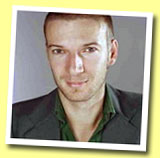 |
| |
|
April
20, 2007 |
|
 |

|
TASTING
– TWO PORT ELLENS BY THE WHISKY
FAIR
Port
Ellen 25 yo 1980/2006 (54.2%, The
Whisky Fair, cask #2562)
 Colour: pale gold. Nose: this is
pure, crystal-clean Port Ellen without
make-up. It starts a little spirity
like most Port Ellens (I think)
and gets then as mineral, tarry
and maritime as it can get.
Colour: pale gold. Nose: this is
pure, crystal-clean Port Ellen without
make-up. It starts a little spirity
like most Port Ellens (I think)
and gets then as mineral, tarry
and maritime as it can get. |
| Actually,
it stays on camphor and tar for a
moment, then it’s waxed paper
and linseed oil, then turpentine and
motor oil, then we have a vegetal
digression (fresh almonds and apple
skin) and finally seashells, kelp
and fisherman’s net. And finally
loads of lime and lemon – how
interesting here. And it’s so
clean and straightforward… Excellent
refill cask (it doesn’t have
too much say, actually). Mouth: an
amazingly powerful and rich attack
– thicker and more ‘invading’
than on the nose. The lime is here
right from the start as well as lemon
and grapefruit, all that mixed with
a bold peatiness, pepper, wax and
‘tarry’ liquorice. Just
superb, getting more and more lemony.
Kind of an ueber-ti-punch if you like.
Great. Finish: long, still very lemony,
tarry (very), peaty and waxy…
And a pinch of salt. Excellent and
entertaining. 93 points. |
Port
Ellen 23 yo 1983/2007 (56.7%, The Whisky
Fair, 150 bottles)
 Hard not to guess who provided The
Whisky Fair with this bottling ;-).
Colour: pale amber. Nose: more cask
influence in this one and even if
the label says it’s a bourbon
hogshead, I’d bet there’s
a little sherry (maybe a few staves?)
with the typical rubbery notes. Now,
it’s true this one is much more
on vanilla and toffee (Werther’s)
at the start, but the peat blast does
happen after that and the whole gets
then more medicinal, camphory and
iodized than the 1980. Excellent again
but maybe simpler and less ultra-clean
than the 1980. And less unusual. Mouth:
indeed, it’s more classical
than the 1980, much less lemony but
certainly not less thrilling. More
tar, probably a little more peat than
in the 1980, all that coated with
a little caramel, vanilla and camphor/eucalyptus
(cough sweets). Extremely compact,
getting very liquoricy (salmiak),
rich, almost thick but never lumpish…
Err, peat marmalade anyone? Finish,
long, very long, still very compact,
peaty and tarry, with the just the
right amount of caramel and maybe
even fir honey to prevent it from
getting too sharp. Immensely tarry
aftertaste. Maybe a little better
than the 1980 on the palate, but I
like the 1980’s nose a little
better… Hmmm, scratch, scratch…
okay, same rating: 93 points.
Well selected, whisky flair! I mean,
whisky fair…
Hard not to guess who provided The
Whisky Fair with this bottling ;-).
Colour: pale amber. Nose: more cask
influence in this one and even if
the label says it’s a bourbon
hogshead, I’d bet there’s
a little sherry (maybe a few staves?)
with the typical rubbery notes. Now,
it’s true this one is much more
on vanilla and toffee (Werther’s)
at the start, but the peat blast does
happen after that and the whole gets
then more medicinal, camphory and
iodized than the 1980. Excellent again
but maybe simpler and less ultra-clean
than the 1980. And less unusual. Mouth:
indeed, it’s more classical
than the 1980, much less lemony but
certainly not less thrilling. More
tar, probably a little more peat than
in the 1980, all that coated with
a little caramel, vanilla and camphor/eucalyptus
(cough sweets). Extremely compact,
getting very liquoricy (salmiak),
rich, almost thick but never lumpish…
Err, peat marmalade anyone? Finish,
long, very long, still very compact,
peaty and tarry, with the just the
right amount of caramel and maybe
even fir honey to prevent it from
getting too sharp. Immensely tarry
aftertaste. Maybe a little better
than the 1980 on the palate, but I
like the 1980’s nose a little
better… Hmmm, scratch, scratch…
okay, same rating: 93 points.
Well selected, whisky flair! I mean,
whisky fair… |
| MUSIC
–
Recommended
listening: why not a little Andrew
Bird today? Not that
he needs any further support but,
well, we do like his Heretics.mp3
(a demo version I think). Please buy
Andrew Bird's music. |
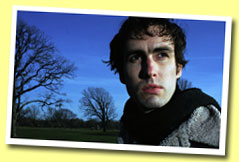 |
| |
|
April
19, 2007 |
|
 |
| TASTING
– TWO GLEN GLEN GRANTS FROM
THE 50’s |
 |
Glen
Grant 25 yo 1952/1977 'Silver Jubilee'
(43%, OB, Directors’ Reserve)
 That’s right, we already
had this one and we rated it very
poorly (55 points) while wondering
if it wasn’t a defective bottle.
Now, after having admired the wonderful
Helen Mirren in Stephen Frears’
The Queen right yesterday and, more
seriously, after having received a
sample from another bottle from our
friend Carsten (MARA), I’m more
than happy to be able to give it another
try.
That’s right, we already
had this one and we rated it very
poorly (55 points) while wondering
if it wasn’t a defective bottle.
Now, after having admired the wonderful
Helen Mirren in Stephen Frears’
The Queen right yesterday and, more
seriously, after having received a
sample from another bottle from our
friend Carsten (MARA), I’m more
than happy to be able to give it another
try. |
| Colour:
pale amber. Nose: right, I’m
rereading my older notes and indeed,
this has nothing to do with the stale
rotgut I had two months ago. This
one is loaded with high-class OBE,
roasted caramelized nuts, mint, camphor,
wax polish and honeydew. And, not
to forget, very ripe mirabelle plums
(the little yellow ones), spearmint
and lemon balm – and also dried
parsley, getting back to the most
beautiful metallic aspects of OBE.
Superb, very, very classy. Mouth:
again, an attack in top form considering
its age. Not exactly powerful but
certainly not wobbly, still very malty
at first sip, nutty, candied and slightly
mentholated. Okay, the middle is slightly
weaker and maybe a tad cardboardy
and drying but it’s still most
pleasant, with enjoyable notes of
tea. Finish: pretty long, honeyed,
a little cereally, with more mint
again, cough sweets, tea… The
whole is beautiful whisky, especially
the magnificent nose and the great
attack on the palate. The rest is
a little weaker but who cares, it’s
royal indeed. 91 points.
(and many thanks, Carsten). Now, a
warning, the first sample I had came
from an unscrupulous retailer, a bad
egg who seems to have sold as ‘regular’
samples several rests of old stale
long-opened bottles via the Internet.
So, please check any seller’s
reputation before you fall into this
kind of ugly trap and ask him to tell
you when he opened the bottle(s). |
Glen
Grant 40 yo 1959/1999 (48.9%, Whisky
Club of Austria, issued 2007, 22 bottles)
 It’s our friends Heinz and Konstantin
from the WCOA (K. is also a Malt Maniac
of course) who could put their hands
on a stash of old unlabelled Glen
Grants, which they just decided to
issue under their own label. Hey Konstantin,
nice label by the way, very ‘The
Avengers’, vintage 1967! Anyway,
let’s try the content now…
Colour: amber. Nose: what’s
really impressive is that we’re
more or less in the same league, with
just more sherry (beautiful ‘artisan’
chocolate) and probably more roasted
nuts and honey-coated fruits. Faint
start of OBE, slight mustiness and
indeed something ‘delicately’
metallic. And then the same mint and
fresh herbs (parsley again, chives,
sage) plus a little genuine balsamico.
Also whiffs of wet hay and of ‘the
cleanest of the smallest wet dogs’.
Just as beautiful as the royal 1952.
Mouth: how thick and concentrated
this is! You almost need a spoon.
Starts on rather classical sherry
(very clean) but gets then superbly
‘freshly’ fruity, which
is very unusual with these very old
so-called sherry monsters. There’s
quite some ripe pineapple, morello
cherries, kirsch (Austrian of course),
crystallised oranges, ‘arranged’
rum… Then it’s the praline,
something resinous (mastic sweets?),
argan oil (which I looooove), hints
of rose-flavoured Turkish delights
and then mint drops… And contrarily
to the 1952, it never, ever ‘wobbles’.
Finish: long, still very thick and
almost pervasive (in a good way),
beautifully candied. Yes there are
some tannins and a slight vinosity
but they never manage to get the upper
hand. Konstantin, where did you say
you found this lot? 93 points.
It’s our friends Heinz and Konstantin
from the WCOA (K. is also a Malt Maniac
of course) who could put their hands
on a stash of old unlabelled Glen
Grants, which they just decided to
issue under their own label. Hey Konstantin,
nice label by the way, very ‘The
Avengers’, vintage 1967! Anyway,
let’s try the content now…
Colour: amber. Nose: what’s
really impressive is that we’re
more or less in the same league, with
just more sherry (beautiful ‘artisan’
chocolate) and probably more roasted
nuts and honey-coated fruits. Faint
start of OBE, slight mustiness and
indeed something ‘delicately’
metallic. And then the same mint and
fresh herbs (parsley again, chives,
sage) plus a little genuine balsamico.
Also whiffs of wet hay and of ‘the
cleanest of the smallest wet dogs’.
Just as beautiful as the royal 1952.
Mouth: how thick and concentrated
this is! You almost need a spoon.
Starts on rather classical sherry
(very clean) but gets then superbly
‘freshly’ fruity, which
is very unusual with these very old
so-called sherry monsters. There’s
quite some ripe pineapple, morello
cherries, kirsch (Austrian of course),
crystallised oranges, ‘arranged’
rum… Then it’s the praline,
something resinous (mastic sweets?),
argan oil (which I looooove), hints
of rose-flavoured Turkish delights
and then mint drops… And contrarily
to the 1952, it never, ever ‘wobbles’.
Finish: long, still very thick and
almost pervasive (in a good way),
beautifully candied. Yes there are
some tannins and a slight vinosity
but they never manage to get the upper
hand. Konstantin, where did you say
you found this lot? 93 points. |
| MUSIC
–
Recommended
listening: Janis'
younger sister? No, no, she's Beth
Hart and she's singing
I'm
the one.mp3. Please buy Beth Hart's
music. |
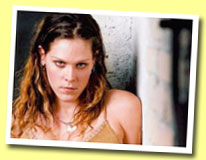 |
| |
|
April
18, 2007 |
|
 |
CONCERT
REVIEW by Nick Morgan
IAN SIEGAL AND HIS BAND The
100 Club, London, April 12th 2007 |
 |
Telecaster,
Stratotone, pin-striped jacket,
Cornell amp and Jim Beam Black... |
| Eagle-eyed
readers may remember that I recently
wrote that hot-shot USA guitar sensation
Joe Bonamassa liked to wear his influences
on his sleeve. Well move over big
boy (did I mention that Joe appears
to be aiming for Gallagher’s
girth as well as his guitar technique?),
English blues prodigy Ian
Siegal has gone one better.
He wears his influence on his left
arm, where he sports a huge tattoo
of McKinley Morganfield, aka Muddy
Waters, who along with Chester
Burnett (the Howling Wolf) are probably
his greatest inspirations. You can
hear this on his excellent 2005 album
Meat and Potatoes, but if you want
to get the full impact of this British
take on an urbanised Delta style,
then you must see him live with his
equally excellent band. It’s
quite simply a blues sensation. |
| It’s
another steamy night in the 100 Club,
with a highly partisan crowd, many
of whom are regulars at It
Ain’t Nothing But the Blues,
where Siegal
had a virtual residency last year.
There are the usual horde of hoary
old blues hands, and a notable contingent
of ladies of all ages, many of whom
take to the front of the stage as
Siegal’s performance progresses.
The layout at the 100 Club isn’t
the best in the world – and
I’m perched in front of a pillar
a few feet from stage centre almost
eyeball to fret board with Siegal.
Believe me it’s uncomfortable
taking notes at such a visible proximity,
so apart from a few scribbles I adopt
the same rather vacant and witless
expression of a blues guitar anorak
(which comes remarkably easily) as
do most of the males around me, and
instead write up the gig in the cab
on the way home. And it’s a
Thursday – no beer, no wine. |
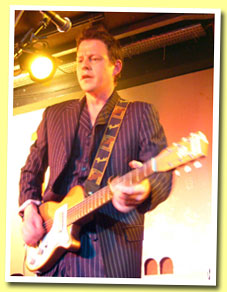 |
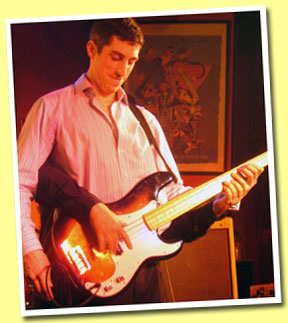 |
Siegal
takes the stage in an ill-matched
pin-striped suit and snakeskin cowboy
boots clutching a bottle of Jim Beam
Black. He picks up a 1950s
Harmony Stratotone H44 (pick-up
apparently held on only by sellotape)
and lashes into the first tune (title
unknown, apparently from his forthcoming
new album), followed by a blistering
version of John Lee Hooker’s
‘Groundhog blues’ and
‘Cath 22’ (not a spelling
mistake, a new song, but I might have
misheard). The guitar (he’s
using a bashed up Cornell amplifier)
has a fantastic crisp sound –
the groove is pure Delta meets Chicago,
driven by drummer Nikolaj Bjerre and
bassist Andy Graham who occasionally
sounds like Norman Watt Roy. Anyone
would think he had two sets of hands!
|
| And
what shines out even more than Siegal’s
intense playing is his voice –
it’s a mastery of styles, mainly
Waters and Wolf. But it’s not
pastiche, it’s more about vocal
technique and style – here’s
a quote from Robert Palmer’s
Deep Blues (talking about Waters)
that explains exactly what Siegal
was up to: “he screws up the
side of his face and then relaxes
it, opens and contracts his throat,
shakes his jowls, constantly readjusts
the shape of his mouth cavity, all
in order to get different, precisely
calibrated vocal sounds, from the
purest falsetto to deep, quivering
moans to a grainy, vibrato heavy rasp”.
The only time it gets uncomfortably
close to copying is when Siegal dispenses
with his Harmony (did I mention it
was a Stratotone H44?) to sing ‘God
don’t like ugly’, best
described as a bit of a Tom Waits
moment. |
 |
| The
second half of the set sees Siegal
playing his gloriously battered Fender
Telecaster (it might have been the
’69) as he works his way through
a few songs from Meat and Potatoes
– ‘Sugar rush’,
‘Revelator’ and ‘She’s
got the devil in her’ (during
which he finds time to smoke a Black
Devil and shift half a large glass
of bourbon). His songs are good –
with interesting structures (despite
the restrictions of the 12 bar medium)
and darkly witty lyrics (even if he
does go a bit Apocalyptic on ‘Revelator’).
On the Telecaster his playing is as
strong and aggressive as on the Harmony
(you know – the Stratotone)
until he moves to ‘conventional’
single string lead guitar style where
he’s not quite as convincing
– but hey, then neither was
Muddy Waters. He leads the band along
a sometime unpredictable path –
they seemed as surprised as us when
a verse and chorus of ‘Fulsome
Prison Blues’ came out of nowhere
in one of the earlier songs. For the
final tune Siegal is joined on stage
by harmonica player Johnny
Mastro, who with his band the
Mamas
Boys (their first gig in the UK)
had played a rollicking support set,
and his guitarist Dave Melton for
a hastily agreed ”Muddy Waters
blues in G”. He then returns,
as the clock pushes eleven o’clock,
with ‘Falling on down again’,
an R&B ballad that Stax would
have been proud of. |
| So
our Mr Siegal is quite a piece of
work, both CD and live performance
highly recommended. Mature song writing
skills, a great and versatile voice,
a seriously studied blues vocal style,
a fierce and frenetic guitar technique,
an engaging and authoritative stage
presence, a bit of the sexy stuff
thrown in, and he has a 1950s Harmony
Stratotone H44. Oh yes – he
likes bourbon too – but I suppose
you can’t get everything right
… - Nick Morgan (photographs
by Kate) |
| Many
thanks, Nick. Well, I guess you
can't really expect somebody wearing
snakeskin boots to quaff Brora 30
or Talisker 25, can you? I beg your
pardon? You say people wearing pin-striped
suits do? Hmm... yes, but do they
have Telecasters? Agreed, this leads
us to nowhere, sorry. Let's rather
admire The Photographer's beautiful
pictures of drummer Nikolaj
Bjerre and of Johnny
Mastro and listen to two great
tunes by Ian Siegal on his Myspace
page. |
| TASTING
– TWO OLD GLENLIVETS |
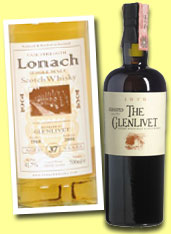 |
Glenlivet
37 yo 1968/2006 (41.7%, Duncan Taylor's
Lonach)  colour: pale gold. Nose: expressive
and much fresher and cleaner than
expected, starting with lots of flowers
(dandelions, buttercups), pollen and
fresh white fruits (peaches). Goes
on with a little vanilla and quite
some fresh butter, never getting woody.
Hints of fresh mint. Not enormously
complex but very pleasant and surprisingly
young despite all what the angels
have stolen. Mouth: starts rather
light but not weak, with quite some
wood now but it’s far from being
unbearable. Enjoyable spiciness (nutmeg
and white pepper as well as quite
some cinnamon). Other than that we
have vanilla, pecan pie, apple compote…
Again, it’s not really complex
but pleasant and flawless. The finish
isn’t too long, though, but
balanced, vanilled and still not drying.
A good oldie that didn’t go
off the rail despite all these years.
85 points.
colour: pale gold. Nose: expressive
and much fresher and cleaner than
expected, starting with lots of flowers
(dandelions, buttercups), pollen and
fresh white fruits (peaches). Goes
on with a little vanilla and quite
some fresh butter, never getting woody.
Hints of fresh mint. Not enormously
complex but very pleasant and surprisingly
young despite all what the angels
have stolen. Mouth: starts rather
light but not weak, with quite some
wood now but it’s far from being
unbearable. Enjoyable spiciness (nutmeg
and white pepper as well as quite
some cinnamon). Other than that we
have vanilla, pecan pie, apple compote…
Again, it’s not really complex
but pleasant and flawless. The finish
isn’t too long, though, but
balanced, vanilled and still not drying.
A good oldie that didn’t go
off the rail despite all these years.
85 points. |
Glenlivet
1971 (45%, Samaroli, single cask,
circa 2002)  Colour: full amber. Nose: this one
starts much more on sherry (lots of
sultanas), with also lots of caramel
and toasted brioche as well as apricot
pie. Something ‘old’ like
in old bottles. Hints of metal, mint,
slight mustiness. Gets even more candied
after that and very orangey (Grand
Marnier). Hints of coal and wet stones.
It never gets vinous and rather stays
always quite elegant and delicately
candied, with notes of coffee-flavoured
toffee. Quite beautiful, this Glenlivet
by Samaroli, I’m wondering why
nobody knows of it. Mouth: the attack
is drier, on lots of unsugared espresso
and bitter chocolate but with balance.
Notes of old rancio developing, cloves,
Seville oranges and a little candy
sugar. Maybe a little simpler than
on the nose. Quite some raisin as
well (more Smyrna than sultanas) and
notes of old rum. Finish: quite long,
on bitter caramel and coffee…
Well, there was more happening on
the nose but it’s still an excellent
old Glenlivet. 87 points.
Colour: full amber. Nose: this one
starts much more on sherry (lots of
sultanas), with also lots of caramel
and toasted brioche as well as apricot
pie. Something ‘old’ like
in old bottles. Hints of metal, mint,
slight mustiness. Gets even more candied
after that and very orangey (Grand
Marnier). Hints of coal and wet stones.
It never gets vinous and rather stays
always quite elegant and delicately
candied, with notes of coffee-flavoured
toffee. Quite beautiful, this Glenlivet
by Samaroli, I’m wondering why
nobody knows of it. Mouth: the attack
is drier, on lots of unsugared espresso
and bitter chocolate but with balance.
Notes of old rancio developing, cloves,
Seville oranges and a little candy
sugar. Maybe a little simpler than
on the nose. Quite some raisin as
well (more Smyrna than sultanas) and
notes of old rum. Finish: quite long,
on bitter caramel and coffee…
Well, there was more happening on
the nose but it’s still an excellent
old Glenlivet. 87 points. |
| |
|
April
17, 2007 |
|
 |
| MALT
MANIACS NEWSFLASH by
Johannes van den Heuvel |
| 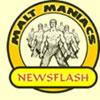
|
|
It
has been a while since we
published a fresh issue of
Malt Maniacs (some seven weeks,
to be precise), but now that
the festival season has started
again we have plenty to write
about, so Malt Maniacs #103
is emerging on the horizon.
To keep you informed until
it arrives; here's a very
quick impression from the
Pot Still Festival
in Leusden, Holland which
was attended by Michel van
Meersbergen and yours truly. |
|
In the middle of April we enjoyed
some glorious summer weather
that would make Al Gore proud.
It was the earliest 'summer
day' recorded since the Dutch
climate institute started making
notes. At a few places temperatures
even rose past 30 degrees celcius,
qualifying the day officially
as 'tropical' by the moderate
Dutch standards - less than
a month after Spring has officially
started. We could be in for
a hot summer... |
| But
enough chatting with myself
about the weather... I THOUGHT
I had made an amazing discovery
in the form of a Convalmore
28 yo OB (great 'retro' label)
but as it turns out we already
tasted it (and gave it solid
silver) at the MM Awards 2006.
Well, since we taste the samples
'blind' I hadn't seen the bottle.
Very nice indeed - would look
great on my shelf but it's a
lot of money... I hung around
the Duncan Taylor stand for
quite a while and was surprised
by the range of VERY old whiskies
they presented at the festival.
Personal favourits included
a Caperdonich 38 yo 1968/2006
( 56.3%, Duncan Taylor, 88 points)
and a Bunnahabhain 38 yo (43.1%,
Duncan Taylor, C#11571, 87 points).
At the other stands the bottles
that made a big impression were
the Ayrshire 32 yo 1975/2007
(46%, Signatory, C#556, 265
Bts., Ladyburn distillery, surprisingly
affordable), a peated (!) Bunnahabhain
9 yo 1997/2007 (59%, Signatory
Vintage, C#5272) and a Longmorn
1973/2006 (51,4%, G&M, C#6350).
|
| Anyway,
I hope to publish a fresh report
on Malt Madness or Malt Maniacs
shortly - and Michel and Thomas
are working on a 'festival'
report for MM#103 as well. As
far as other news is concerned:
Ulf's latest whisky book (about
the 'UD Rare Malts' range from
Diageo) won a luxurious award
for 'the best spirits
book of the world 2007'
- or something along those lines.
Congrats, Ulf! |
|
| TASTING
– FIVE RATHER OLD CAOL ILAS |
 |
Caol
Ila 25 yo 1982/2007 (55.5%, James MacArthur,
Special Reserve, cask #731)  Colour: gold. Nose:
not too explosive, rather smooth at
first sniffs, with rather notes of
fresh butter, dairy cream and apple
juice. What’s interesting is
that it gets then beautifully smoky,
but it’s not the ‘peaty’
kind of smoke, rather beech smoke,
cold fireplace and matchsticks. The
whole is rather fresh and very clean.
Faint hints of mint leaves and celery…
And finally lots of fresh fruits (fresh
strawberries and pears). Smoked fruits?
Pleasant development, this one is
multilayered and you must give it
time. With water: huge soapiness,
which is quite normal. Let’s
wait… Ah, now it got a little
more silent, much less smoky but maybe
a little fruitier. Quite some vanilla
now. Mouth (neat): very sweet and
very peaty, with an unusually high
fruitiness (the strawberries again).
Much less complex than on the nose,
with no coastal notes at all, but
bl**dy drinkable, even at cask strength.
With water: oh, now we have beautiful
notes of gentian spirit (which I looove),
roots, pepper, liquorice roots and
quite some salt, the ‘coastality’
arising now. Finish: rather long,
balanced, maybe simpler again, peaty,
peppery and fruity (cooked apples).
Very good; maybe not magic but very
good. 88 points.
Colour: gold. Nose:
not too explosive, rather smooth at
first sniffs, with rather notes of
fresh butter, dairy cream and apple
juice. What’s interesting is
that it gets then beautifully smoky,
but it’s not the ‘peaty’
kind of smoke, rather beech smoke,
cold fireplace and matchsticks. The
whole is rather fresh and very clean.
Faint hints of mint leaves and celery…
And finally lots of fresh fruits (fresh
strawberries and pears). Smoked fruits?
Pleasant development, this one is
multilayered and you must give it
time. With water: huge soapiness,
which is quite normal. Let’s
wait… Ah, now it got a little
more silent, much less smoky but maybe
a little fruitier. Quite some vanilla
now. Mouth (neat): very sweet and
very peaty, with an unusually high
fruitiness (the strawberries again).
Much less complex than on the nose,
with no coastal notes at all, but
bl**dy drinkable, even at cask strength.
With water: oh, now we have beautiful
notes of gentian spirit (which I looove),
roots, pepper, liquorice roots and
quite some salt, the ‘coastality’
arising now. Finish: rather long,
balanced, maybe simpler again, peaty,
peppery and fruity (cooked apples).
Very good; maybe not magic but very
good. 88 points. |
Caol
Ila 22 yo 1984/2007 (55.9%, The Whisky
Fair, 287 bottles)
 From our German friends’ brand
new series. Colour: gold – amber.
Nose: this is very different, there’s
quite some sherry in there. Starts
on lots of flint stones, then we have
the sherry itself (quite dry, Smyrna
raisins and bitter chocolate) mingling
with a rather massive smokiness and
hints of camphor and iodine. Another
case where sherry and peat are really
holding hands and don’t fight
each other. Very elegant I must say,
with also a little mint coming through
after a while. Also notes of pu-erh
tea, which is always good news, and
a discrete rubber. With water: it
gets wilder, much more farmy and peaty,
the sherry sort of beating a retreat
– to the point where it almost
smells like bourbon-matured Caol Ila.
Very interesting and very ‘funny’.
Mouth (neat): powerful, probably more
sherried than on the nose, creamy,
oily, almost ‘spoonable’.
It somewhat reminds me of some Sauternes-finished
peat monsters – the few very
good ones, that is. (No, I’m
not suggesting you can achieve the
same results generally speaking!)
With water: not a lot of difference
I must say. Smoked and peppered sweet
fruits (yellow peaches, apricots,
hints of pineapples). Always quite
sweet, especially at the rather long
finish. Classy stuff even if there’s
probably a little more happening on
the (dry) nose than on the (sweet)
palate. An unusual but effective ‘partnership’
between Caol Ila and the sherry. 90
points.
From our German friends’ brand
new series. Colour: gold – amber.
Nose: this is very different, there’s
quite some sherry in there. Starts
on lots of flint stones, then we have
the sherry itself (quite dry, Smyrna
raisins and bitter chocolate) mingling
with a rather massive smokiness and
hints of camphor and iodine. Another
case where sherry and peat are really
holding hands and don’t fight
each other. Very elegant I must say,
with also a little mint coming through
after a while. Also notes of pu-erh
tea, which is always good news, and
a discrete rubber. With water: it
gets wilder, much more farmy and peaty,
the sherry sort of beating a retreat
– to the point where it almost
smells like bourbon-matured Caol Ila.
Very interesting and very ‘funny’.
Mouth (neat): powerful, probably more
sherried than on the nose, creamy,
oily, almost ‘spoonable’.
It somewhat reminds me of some Sauternes-finished
peat monsters – the few very
good ones, that is. (No, I’m
not suggesting you can achieve the
same results generally speaking!)
With water: not a lot of difference
I must say. Smoked and peppered sweet
fruits (yellow peaches, apricots,
hints of pineapples). Always quite
sweet, especially at the rather long
finish. Classy stuff even if there’s
probably a little more happening on
the (dry) nose than on the (sweet)
palate. An unusual but effective ‘partnership’
between Caol Ila and the sherry. 90
points. |
Caol
Ila 27 yo 1979/2006 (58.1%, JWWW Old
Train Line, cask #2442, 200 bottles)
 Colour: full gold.
Nose: this is different. It’s
the flintier, more austere side of
Caol Ila, probably more maritime as
well. Too bad there’s a little
soap at first nosing (no, it’s
not the glass) and maybe a little
too much rubber, but once all that
has vanished we’re really on
freshly ground black pepper, peat
smoke, oysters, a little mercurochrome,
apple skin, fresh walnuts, paraffin…
With water: this is amusing, there’s
a lot of fresh mint now, and then
it gets a little yeasty and mashy,
almost like a youngster. As often,
it got also much more farmy and ‘organic’
(wet hay and dog and such). It works.
Mouth (neat): excellent and unusual
attack, extremely lemony and sort
of camphory and minty. Not unlike
some lemon balm flavoured sweets (or
something like that). Lots of green
tea as well, pepper, soft curry, mustard
and apple vinegar… Unusual indeed,
and truly beautiful. With water: not
much changes except for some added
notes of bitter almonds and maybe
a little oilive oil. Finish: long,
more resinous now, peaty as it should
be… Excellent bitterness. Another
winning 1979 Caol Ila – and
interesting again, at that. 91
points.
Colour: full gold.
Nose: this is different. It’s
the flintier, more austere side of
Caol Ila, probably more maritime as
well. Too bad there’s a little
soap at first nosing (no, it’s
not the glass) and maybe a little
too much rubber, but once all that
has vanished we’re really on
freshly ground black pepper, peat
smoke, oysters, a little mercurochrome,
apple skin, fresh walnuts, paraffin…
With water: this is amusing, there’s
a lot of fresh mint now, and then
it gets a little yeasty and mashy,
almost like a youngster. As often,
it got also much more farmy and ‘organic’
(wet hay and dog and such). It works.
Mouth (neat): excellent and unusual
attack, extremely lemony and sort
of camphory and minty. Not unlike
some lemon balm flavoured sweets (or
something like that). Lots of green
tea as well, pepper, soft curry, mustard
and apple vinegar… Unusual indeed,
and truly beautiful. With water: not
much changes except for some added
notes of bitter almonds and maybe
a little oilive oil. Finish: long,
more resinous now, peaty as it should
be… Excellent bitterness. Another
winning 1979 Caol Ila – and
interesting again, at that. 91
points. |
Caol
Ila 1979/2006 (60.4%, McKillop’s
Choice)  Colour: full gold. Nose: pretty much
the same whisky. Please read above.
Maybe (I said maybe), a little more
vanilla and milk chocolate and a little
less peat. Maybe… And maybe
a tad grassier. Splitting hairs here.
With water: this one got directly
farmy and much, much peatier than
when unreduced. Superb notes of clean
horse stable and dried mushrooms.
Now, we’re still in the same
territories as the ‘Jack’.
Mouth (neat): again, we’re quite
close to the “Jack’ but
maybe a little more classic. Peat,
lemon and pepper but less unusual
condiments. With water: even more
classic, with maybe a slight sourness
in the background (cider apples).
Finish: very long, clan, sharp, grassy,
peaty, peppery and lemony. Yeah, classic.
89 points.
Colour: full gold. Nose: pretty much
the same whisky. Please read above.
Maybe (I said maybe), a little more
vanilla and milk chocolate and a little
less peat. Maybe… And maybe
a tad grassier. Splitting hairs here.
With water: this one got directly
farmy and much, much peatier than
when unreduced. Superb notes of clean
horse stable and dried mushrooms.
Now, we’re still in the same
territories as the ‘Jack’.
Mouth (neat): again, we’re quite
close to the “Jack’ but
maybe a little more classic. Peat,
lemon and pepper but less unusual
condiments. With water: even more
classic, with maybe a slight sourness
in the background (cider apples).
Finish: very long, clan, sharp, grassy,
peaty, peppery and lemony. Yeah, classic.
89 points. |
Caol
Ila 23 yo 1978/2002 (61.7%, Rare Malts)
 Colour: full gold. Nose: this is sharper,
even more austere, grassier and less
smoky and peaty. Hints of mercurochrome.
I suppose water is needed… Okay,
water gave it a much waxier profile,
even more austere (if that’s
possible), extremely grassy and still
not very smoky. A little mint. Mouth
(neat): now it’s sweeter, bizarrely
rounded, smooth… Fruitier as
well (apples – of course –
but also fresh strawberries) but that
could be the alcohol. Little smoke
and peat until now. With water: closer
to the 1979 we just had but maybe
less clean and pure, and a little
too green for my tastes. And maybe
a tad too simple although it’s
totally flawless other than that –
of course. Long finish but still a
little too much on green apples for
my tastes. Very good but maybe not
the purest expression this time, whilst
the Rare Malts are (should I say were)
usually the cleanest expressions of
any distilleries from Diageo’s
portfolio in my books. 86
points.(and thanks Antoine)
Colour: full gold. Nose: this is sharper,
even more austere, grassier and less
smoky and peaty. Hints of mercurochrome.
I suppose water is needed… Okay,
water gave it a much waxier profile,
even more austere (if that’s
possible), extremely grassy and still
not very smoky. A little mint. Mouth
(neat): now it’s sweeter, bizarrely
rounded, smooth… Fruitier as
well (apples – of course –
but also fresh strawberries) but that
could be the alcohol. Little smoke
and peat until now. With water: closer
to the 1979 we just had but maybe
less clean and pure, and a little
too green for my tastes. And maybe
a tad too simple although it’s
totally flawless other than that –
of course. Long finish but still a
little too much on green apples for
my tastes. Very good but maybe not
the purest expression this time, whilst
the Rare Malts are (should I say were)
usually the cleanest expressions of
any distilleries from Diageo’s
portfolio in my books. 86
points.(and thanks Antoine) |
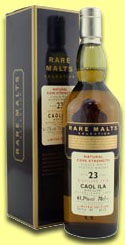 |
| MUSIC
–
Highly recommended
listening: our friend trombonist extraordinaire
Darren
Kramer and his Organisation
(DKO) have a new CD out entitled 'Electric
Quartet'. Not only it's very good
- just like his earlier CD's - but
there's also his Scotch Suite
(aka The Water of Life Suite) on it,
which makes it even more special to
us. The Scotch Suite is composed of
four movements: Oban-Wan Kenobi (Oban
14yr), The Hollow Where The Mill Is
(Lagavulin 16yr), Hebridean Afterglow
(Talisker 10yr) and A Cask Of Thousands
(Macallan Cask Strength 12yr). Not
too sure about the name 'Oban-Wan-Kenobi'
;-) but all the music is really excellent
and full of energy - and Pat Bianchi
is at the B3! So, please buy Darren's
great new record (you can listen to
samples of the Suite there). |
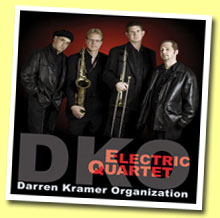
|
| |
|
April
16, 2007 |
|
 |
CONCERT
REVIEW by Nick Morgan
ALABAMA 3 ACOUSTIC The 100
Club, London, April 4th 2007 |
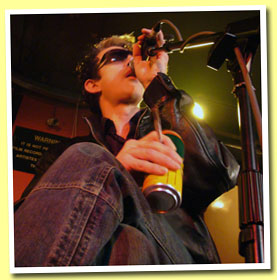 |
It’s
been quite a while since we’ve
heard much of the Alabama
3 - apparently they’ve
been locked
away in a studio making a new
album (“some great tunes, gotta
say” says my inside source).
And they’ve hardly been on stage,
and at the moment only have a few
random gigs planned for the later
this year. But that hasn’t stooped
the indefatigable Rob Spragg, aka
Robert
Love, aka Larry Love, from continuing
to gig with his slimmed down version
of the band, Alabama 3 Acoustic, sometimes
known as the Larry Love Showband.
|
| We
last saw them about three years ago
at Dingwalls – a marvellous
night of red wine and dancing, so
with a free Good Friday night we jumped
at the prospect of another night of
honky-tonk sweet pretty motherfucking
country and western acid-house music.
And did I mention that it’s
a holiday? A holiday, the first one
of the year, and there’s a wonderful
Bank Holiday boozy madness in the
smoke-filled fetid air of the 100
Club (not
for much longer I have to add).
Perfect. |
| There
are four members of this unplugged
outfit. In the engine room is guitarist
Rock Freebase (Mark Sams) whose open
tuned guitar and delta style slide
provide the rhythmical backbone to
proceedings – it’s very
crude, very simple (actually it’s
bloody difficult but you know what
I mean), and very effective. Providing
the overdrive is harmonica player
Harpo Strangelove (Nick
Reynolds) and powerhouse vocalist
the deceptively diminutive Devlin
Love (Zoe Reynolds, wife of Nick).
Actually there’s also a lot
of rhythm coming from regular A3 backing
singers B Attwell and Erroll Thompson
who toast and grime their way through
many of the songs. |
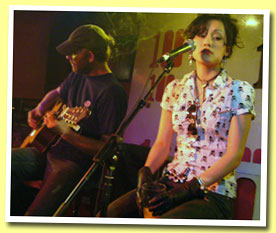
Rock Freebase and Devlin Love |
| Centre
stage of course is the laconic Larry
(“Here’s another motherfucking
miserable song for all you folks out
there”) a latter-day Man in
Black, rarely parted from a beer or
smoke of one sort or another, who
growls his way through the set. |
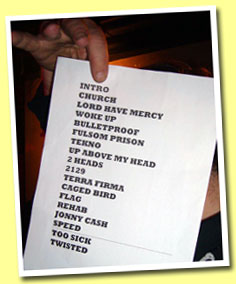
Jozzer stole the set list! |
Luckily
Jozzer – who managed to get
back from his costermonging in time
to hook up with us and his doll Trizza
for a pre-gig Rioja or two and a
bite to eat - got hold of the
set list before the gig. Nice work
Joz – but maybe you should have
put it back as poor old Rock looked
very confused without it. Anyway,
believe me the Brixton mob were in
and it wasn’t a safe place for
a little black notebook – but
fortunately I didn’t have to
attempt to remember what they played.
I do remember Larry thrusting a microphone
in front of my face and me saying
(rather unpersuasively I thought)
“Hello, I’m Johnny Cash”
but the rest of the evening, strangely
like a lot of the Photographer’s
pictures, is a bit of a blur. Having
said that, suspend critical facilities
– this is just about having
good fun, which is what we, and everyone
else, did. That’s what holidays
are for, after all. - Nick Morgan
(photographs by Kate) |
| TASTING
– TWO OLD STRATHISLAS |
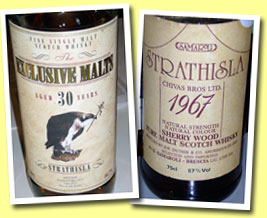 |
Strathisla
30 yo 1976 (46.2%, Exclusive Malts,
Cask #2913, 156 bottles, 2007)
 Colour: gold. Nose: an expressive,
fruity and fresh start on freshly
squeezed oranges, ginger, oak and
hints of eucalyptus. Something unusually
maritime (sea breeze), apple juice,
notes of linseed oil, wax polish…
It smells then more and more like
mint leaves that you’d have
rubbed between your hands, with also
notes of lemon balm and camphor. Complex
and nervous considering its age, perfect.
Colour: gold. Nose: an expressive,
fruity and fresh start on freshly
squeezed oranges, ginger, oak and
hints of eucalyptus. Something unusually
maritime (sea breeze), apple juice,
notes of linseed oil, wax polish…
It smells then more and more like
mint leaves that you’d have
rubbed between your hands, with also
notes of lemon balm and camphor. Complex
and nervous considering its age, perfect.
|
| Mouth:
slightly rougher, less polished than
on the nose but still very expressive.
Nuttier, saltier and more liquoricy.
Goes on with caramel sauce and toasted
brioche, oak, pecan pie… More
on crystallised oranges after that,
but there’s always lots of caramel
and praline. Very good. Finish: long,
candied, caramelized and still slightly
salty. And still no vinosity. Extremely
palatable and quite fresh globally.
Far from the usual ‘thick’
sherry monsters. 90 points. |
Strathisla
1967/1986 (57%, Duthie for Samaroli,
Sherry wood, 360 bottles)  Colour: full amber. Nose:
this one starts heavier but not lumpish,
with a rather fresh sherry (roasted
nuts, milk chocolate, praline and
sultanas). Nice notes of old rum,
triple-sec. It’s more and more
on praline and freshly roasted coffee
beans but also dried figs and bananas.
The balance is perfect and there’s
no vinous and/or sulphury notes whatsoever
here and no meatiness either. Heavy
‘soft’ sherry, I’d
say. Mouth: very nervous attack, woodier
than the 30 yo and more on varnish
and eucalyptus as well as crystallised
oranges. Lots of candy sugar, liquorice
and salt (it’s saltier than
the 1976). Truly concentrated, almost
thick, fat, also with more tannins
than the 1976 – it’s a
little ‘mordant’. Long
and coating finish, with all these
notes of candy sugar and oranges but
also the eucalyptus that’s back
(cough drops). Concentrated indeed,
just as excellent as the 1976, but
not really better, for it’s
really fatter. Same rating then, 90
points.
Colour: full amber. Nose:
this one starts heavier but not lumpish,
with a rather fresh sherry (roasted
nuts, milk chocolate, praline and
sultanas). Nice notes of old rum,
triple-sec. It’s more and more
on praline and freshly roasted coffee
beans but also dried figs and bananas.
The balance is perfect and there’s
no vinous and/or sulphury notes whatsoever
here and no meatiness either. Heavy
‘soft’ sherry, I’d
say. Mouth: very nervous attack, woodier
than the 30 yo and more on varnish
and eucalyptus as well as crystallised
oranges. Lots of candy sugar, liquorice
and salt (it’s saltier than
the 1976). Truly concentrated, almost
thick, fat, also with more tannins
than the 1976 – it’s a
little ‘mordant’. Long
and coating finish, with all these
notes of candy sugar and oranges but
also the eucalyptus that’s back
(cough drops). Concentrated indeed,
just as excellent as the 1976, but
not really better, for it’s
really fatter. Same rating then, 90
points. |
| |
|
April
15, 2007 |
|
 |
| TASTING
– TWO 1988 GLEN GARIOCHS |
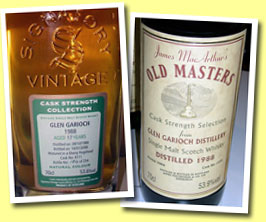 |
Glen Garioch 17 yo 1988/2006 (53.6%,
Signatory, sherry hogshead #4111,
254 bottles)  Colour: gold. Nose: this one starts
on full vanilla-mode, with just hints
of that slight meatiness that one
can find in many recent Glen Gariochs
(ham). Then we have mostly beeswax
and pollen for a while, before it
gets a little harsher and more spirity.
Quite nice but rather simple. Let’s
try it with water: now we have huge
whiffs of buttered mashed potatoes
but it gets then quieter again. It
didn’t change a lot in fact.
Quite neutral.
Colour: gold. Nose: this one starts
on full vanilla-mode, with just hints
of that slight meatiness that one
can find in many recent Glen Gariochs
(ham). Then we have mostly beeswax
and pollen for a while, before it
gets a little harsher and more spirity.
Quite nice but rather simple. Let’s
try it with water: now we have huge
whiffs of buttered mashed potatoes
but it gets then quieter again. It
didn’t change a lot in fact.
Quite neutral. |
| Mouth
(neat): sweet, fruity, spirity…
Lots of apples and not too ripe bananas,
green tea… Maybe a little too
neutral in fact, let’s add water
again: not much development I’m
afraid. It stays simple and, well,
‘neutral’ – and
so does the finish. Not bad at all
but not very inspiring I’d say.
79 points. |
Glen
Garioch 1988/2006 (53.9%, James MacArthur,
cask #1535)  Colour: full gold. Nose: extremely
close to the Signatory at first sniffs,
on vanilla and beeswax but with an
added layer of phenols and resins.
Also more fruits (mostly cider apples).
But water is probably needed again:
that worked better than with the Signatory,
with quite some mint coming out, a
little eucalyptus and camphor, wax,
un-sugared black tea, cigar box…
Closer to ‘Glen Garioch’
as we sometimes know it (reminds me
of much older distillations). Mouth
(neat): again, the attack is a little
more complex (even more green tea
but also more liquorice stick and
apple skin). Notes of kiwis. With
water: that worked again. Lots of
liquorice and apple skin again but
also hints of fir honey, vanilla fudge,
mint-flavoured tea (ah, the medina…),
mint and liquorice sweets… Excellent
oakiness as well, smokiness…
The finish is long and very liquoricy
again, slightly salty and minty, waxy…
An excellent example of a classy recent
‘old style’ Glen Garioch.
Great selection by James MacArthur.
88 points. (and
thanks, Peter)
Colour: full gold. Nose: extremely
close to the Signatory at first sniffs,
on vanilla and beeswax but with an
added layer of phenols and resins.
Also more fruits (mostly cider apples).
But water is probably needed again:
that worked better than with the Signatory,
with quite some mint coming out, a
little eucalyptus and camphor, wax,
un-sugared black tea, cigar box…
Closer to ‘Glen Garioch’
as we sometimes know it (reminds me
of much older distillations). Mouth
(neat): again, the attack is a little
more complex (even more green tea
but also more liquorice stick and
apple skin). Notes of kiwis. With
water: that worked again. Lots of
liquorice and apple skin again but
also hints of fir honey, vanilla fudge,
mint-flavoured tea (ah, the medina…),
mint and liquorice sweets… Excellent
oakiness as well, smokiness…
The finish is long and very liquoricy
again, slightly salty and minty, waxy…
An excellent example of a classy recent
‘old style’ Glen Garioch.
Great selection by James MacArthur.
88 points. (and
thanks, Peter) |
| MUSIC
–
Recommended
listening: it's Sunday, we go classical
with Benjamin
Britten's fabulous Illuminations
(this part is called Villes.mp3).
I think the tenor is Philip Langridge
but I'm not sure. Les Illuminations
op. 18, composed in 1939, are settings
of poems by Arthur Rimbaud. |
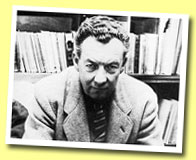 |
Check
the index of all entries:
Whisky
Music
Nick's Concert
Reviews
|
 |
 |
 |
|
| |
Best
malts I had these weeks - 90+
points only - alphabetical:
Braes
of Glenlivet 16 yo 1979/1996 (59%,
Signatory, sherry butt #16045)
Caol
Ila 22 yo 1984/2007 (55.9%,
The Whisky Fair, 287 bottles)
Caol
Ila 27 yo 1979/2006 (58.1%, JWWW Old
Train Line, cask #2442, 200 bottles)
Clynelish
1995/2007 (50%,
Taste Still, Whisky Live Verviers 2007, 302
bottles)
Clynelish
33 yo 1973/2006 (54.2%, Signatory, cask
#8914, 455 bottles)
Glen
Grant 25 yo 1952/1977 'Silver Jubilee' (43%,
OB, Directors’ Reserve)
Glen
Grant 40 yo 1959/1999 (48.9%, Whisky
Club of Austria, issued 2007, 22 bottles)
Highland
Park 15 yo 1990/2005
(57.2%, OB, for Sweden, cask #1602)
Longmorn
35 yo 1968/2004 (51.7%, Scotch Malt
Whisky Society, 7.25)
Port
Ellen 23 yo 1983/2007 (56.7%,
The Whisky Fair, 150 bottles)
Port
Ellen 25 yo 1980/2006 (54.2%, The Whisky
Fair, cask #2562)
Strathisla
1967/1986 (57%, Duthie for Samaroli,
Sherry wood, 360 bottles)
Strathisla
30 yo 1976 (46.2%, Exclusive Malts,
Cask #2913, 156 bottles, 2007)


|
| |
|
|

